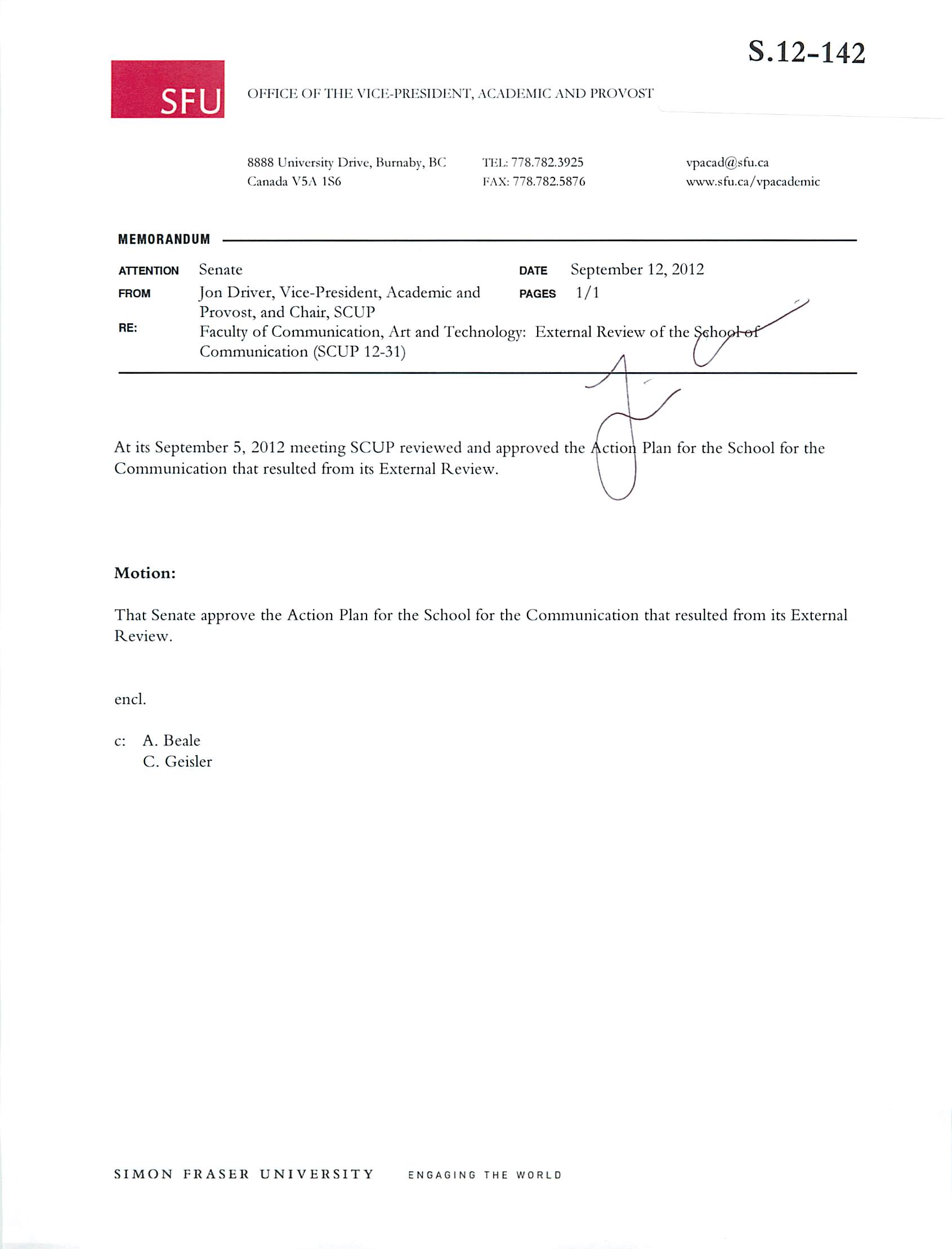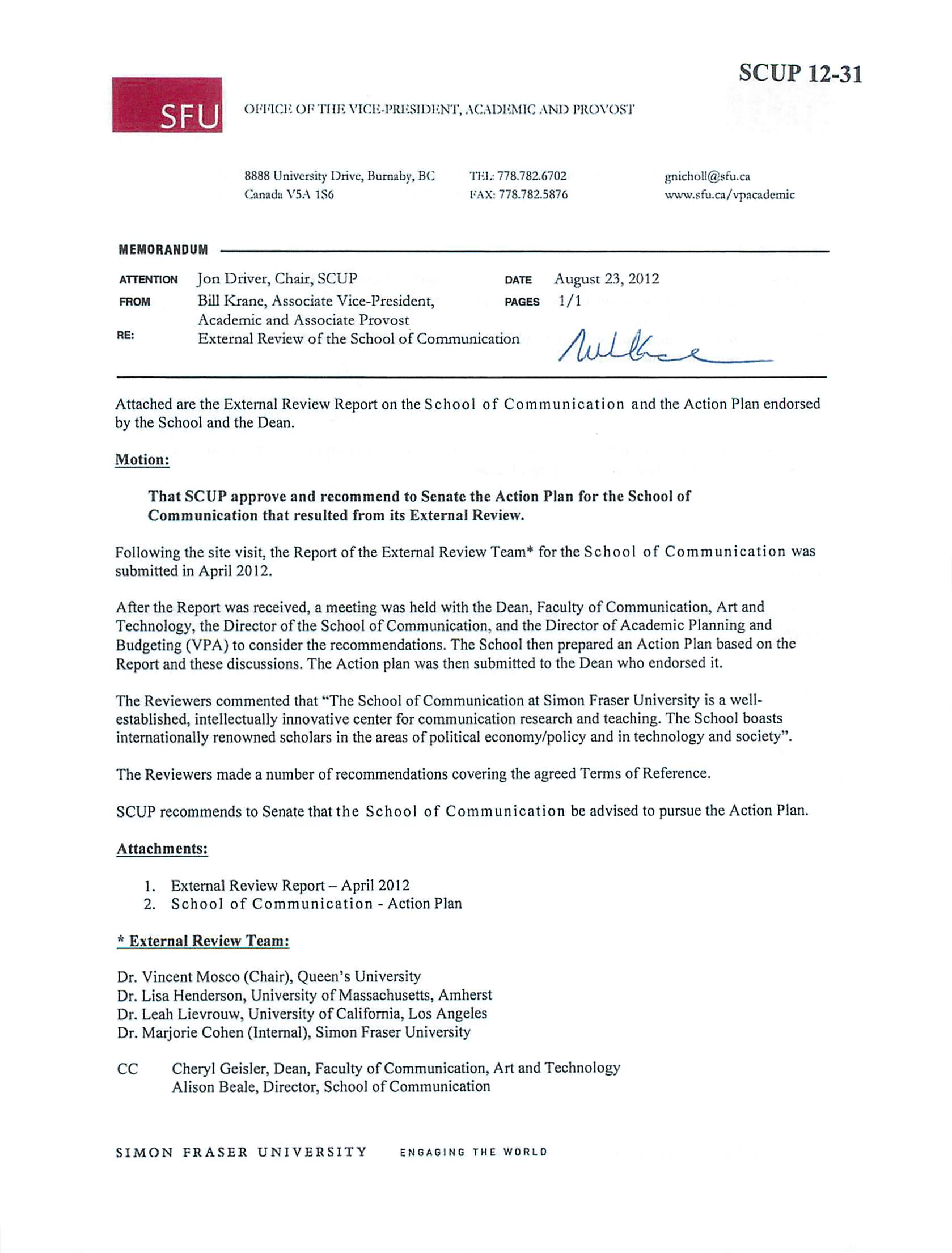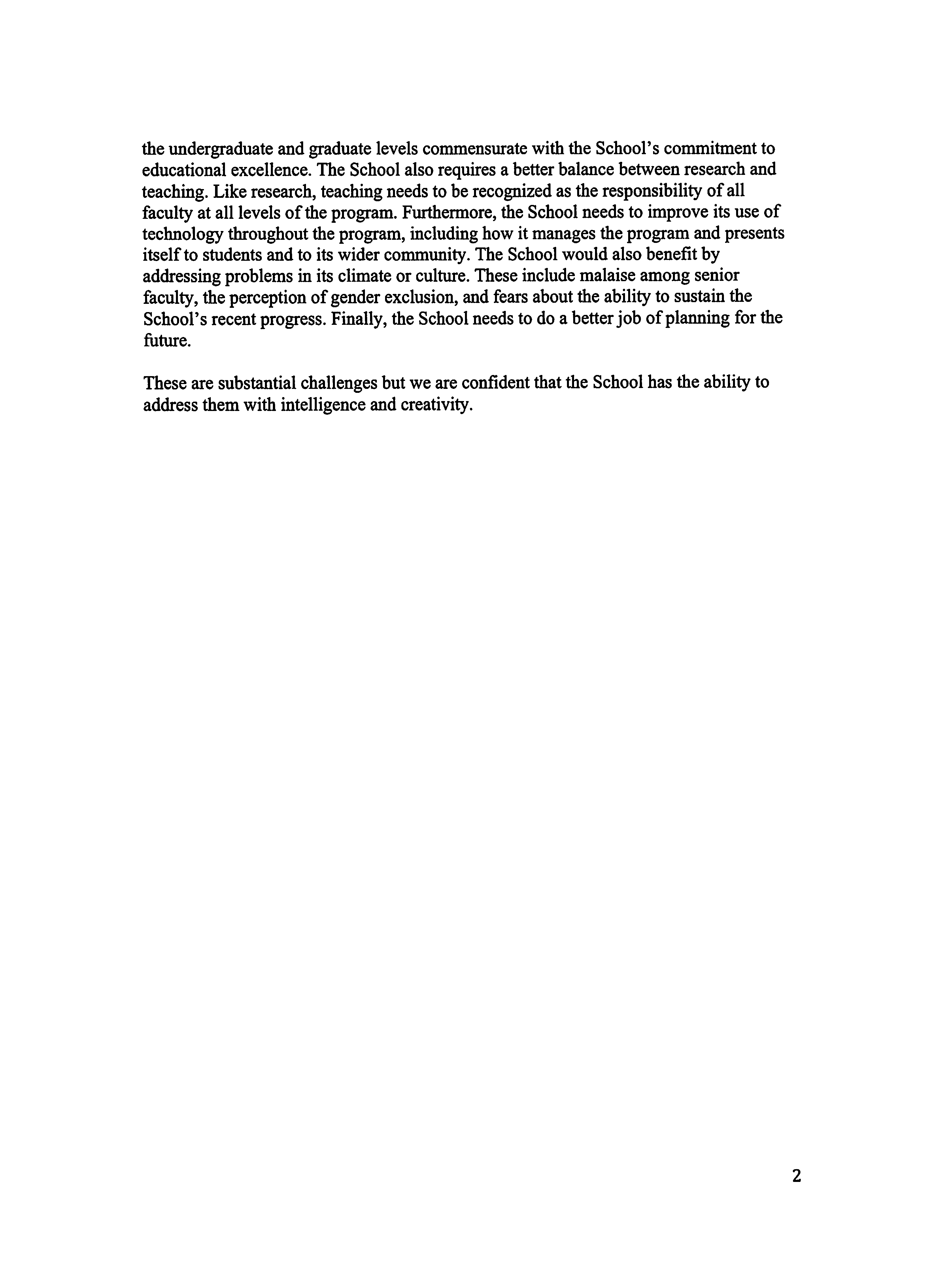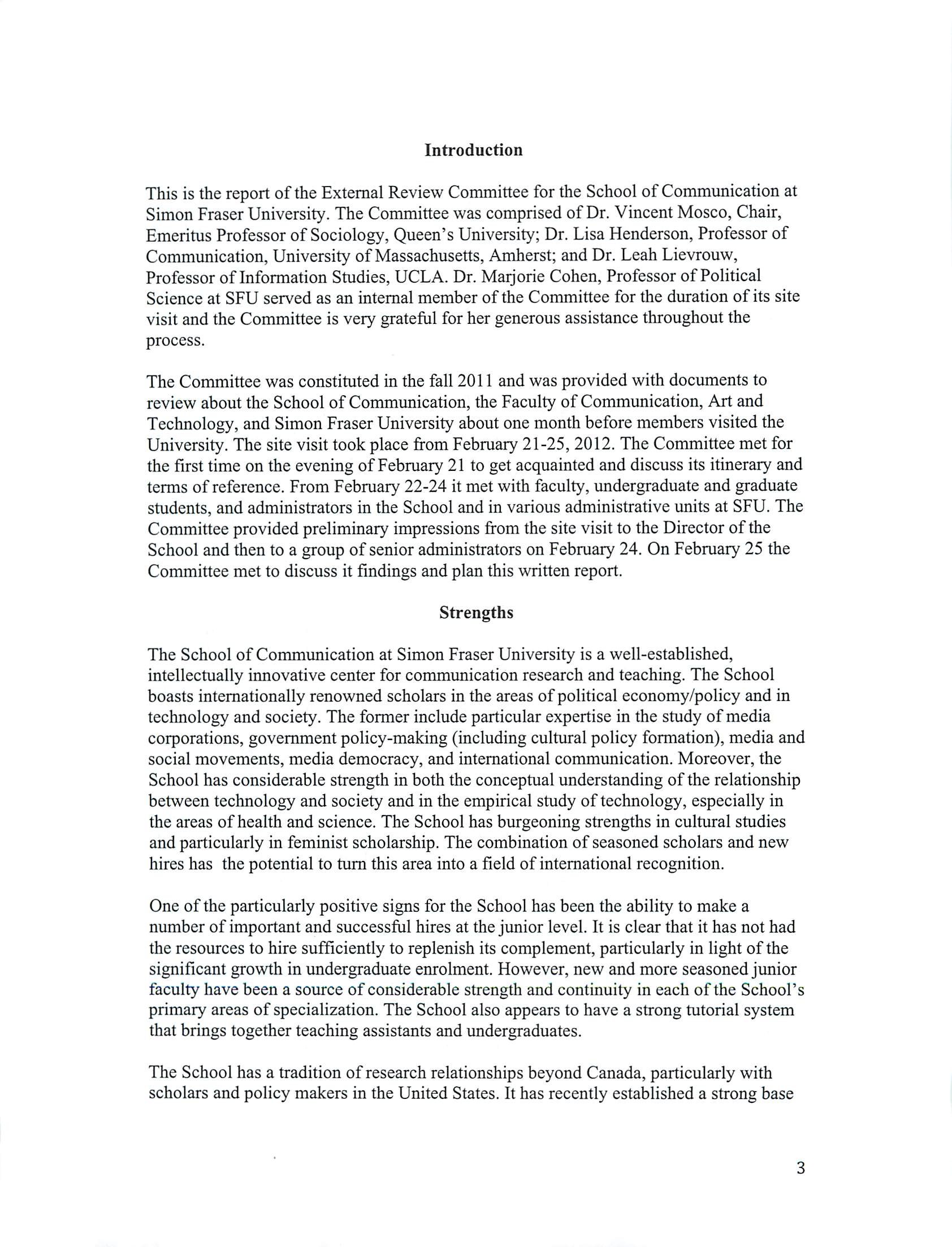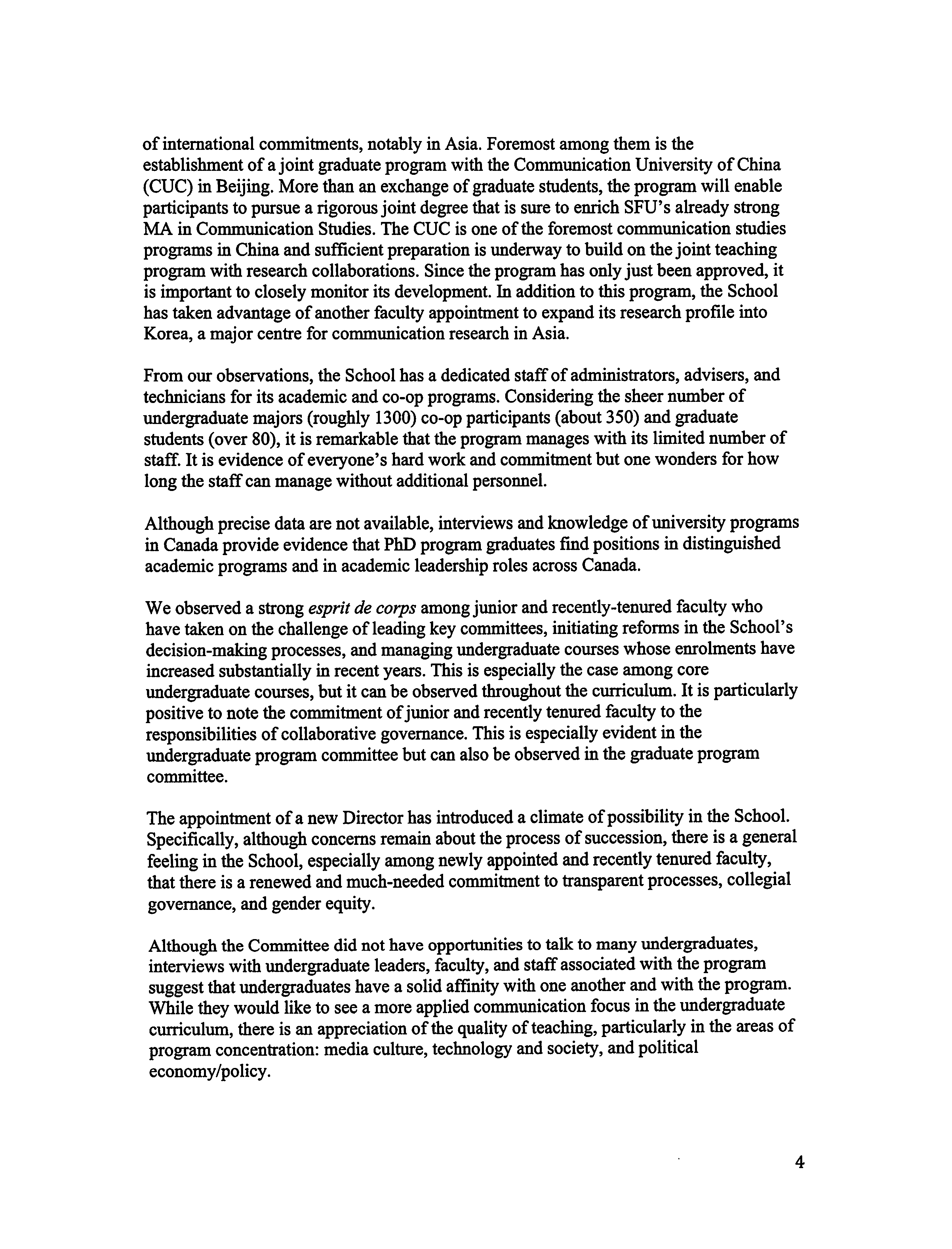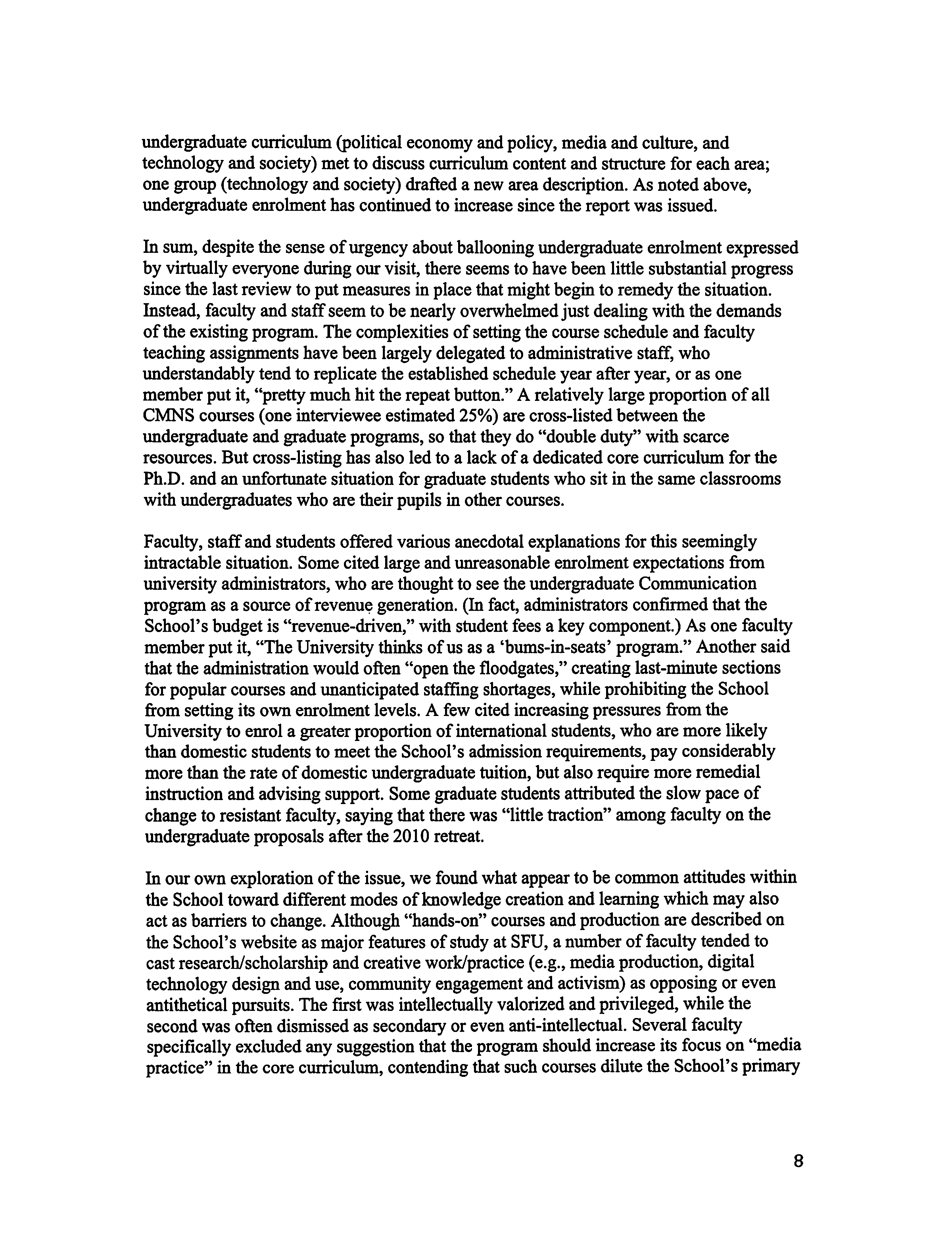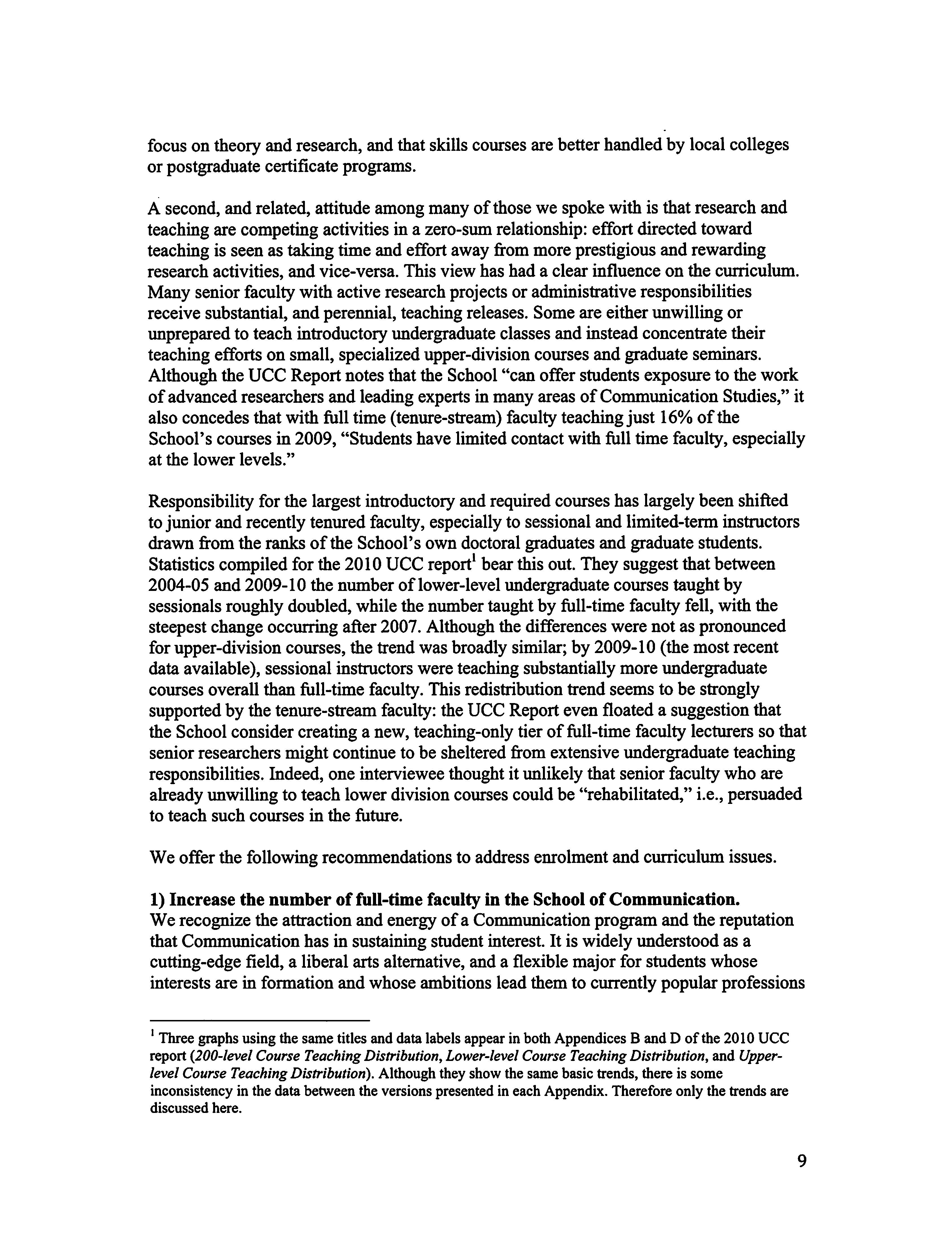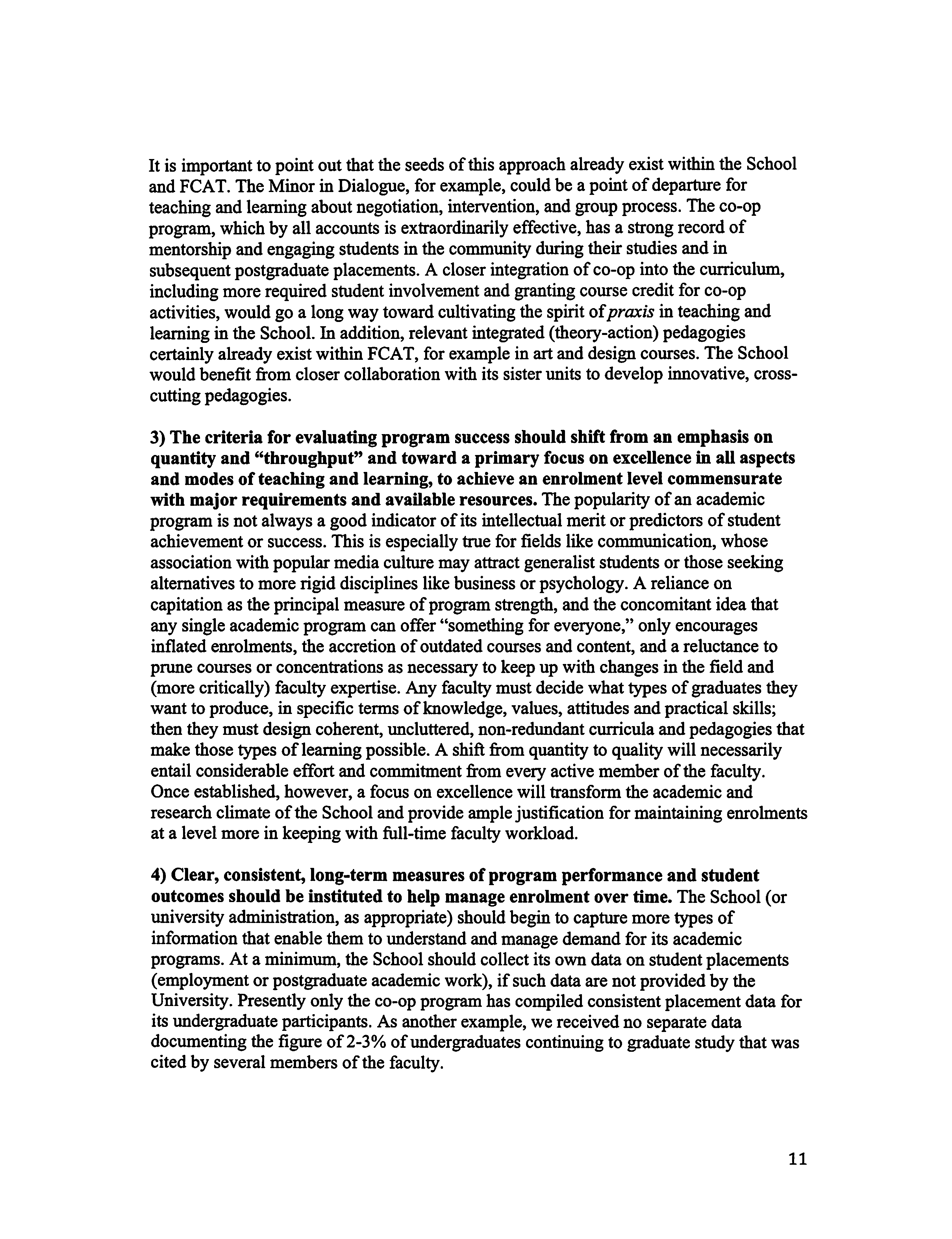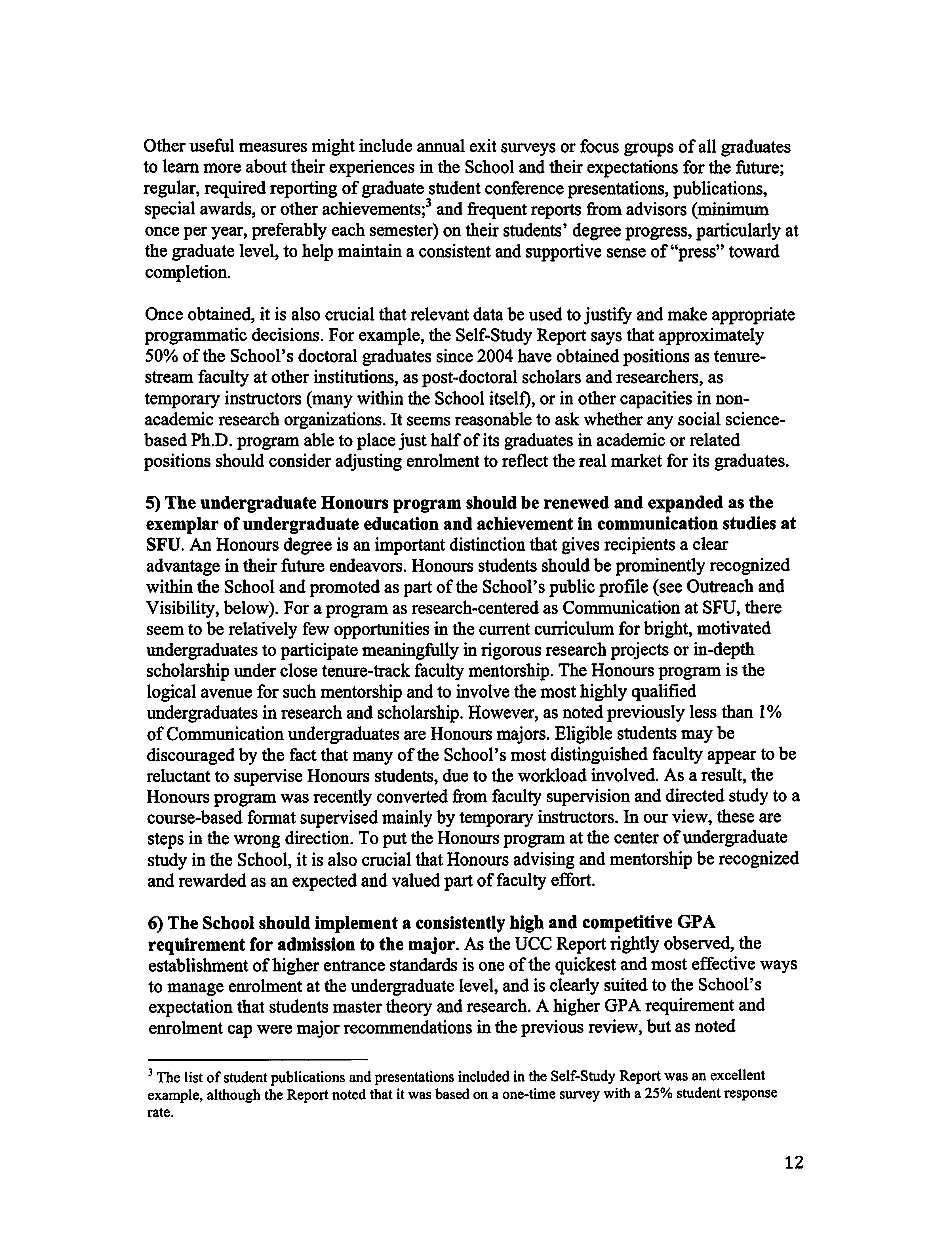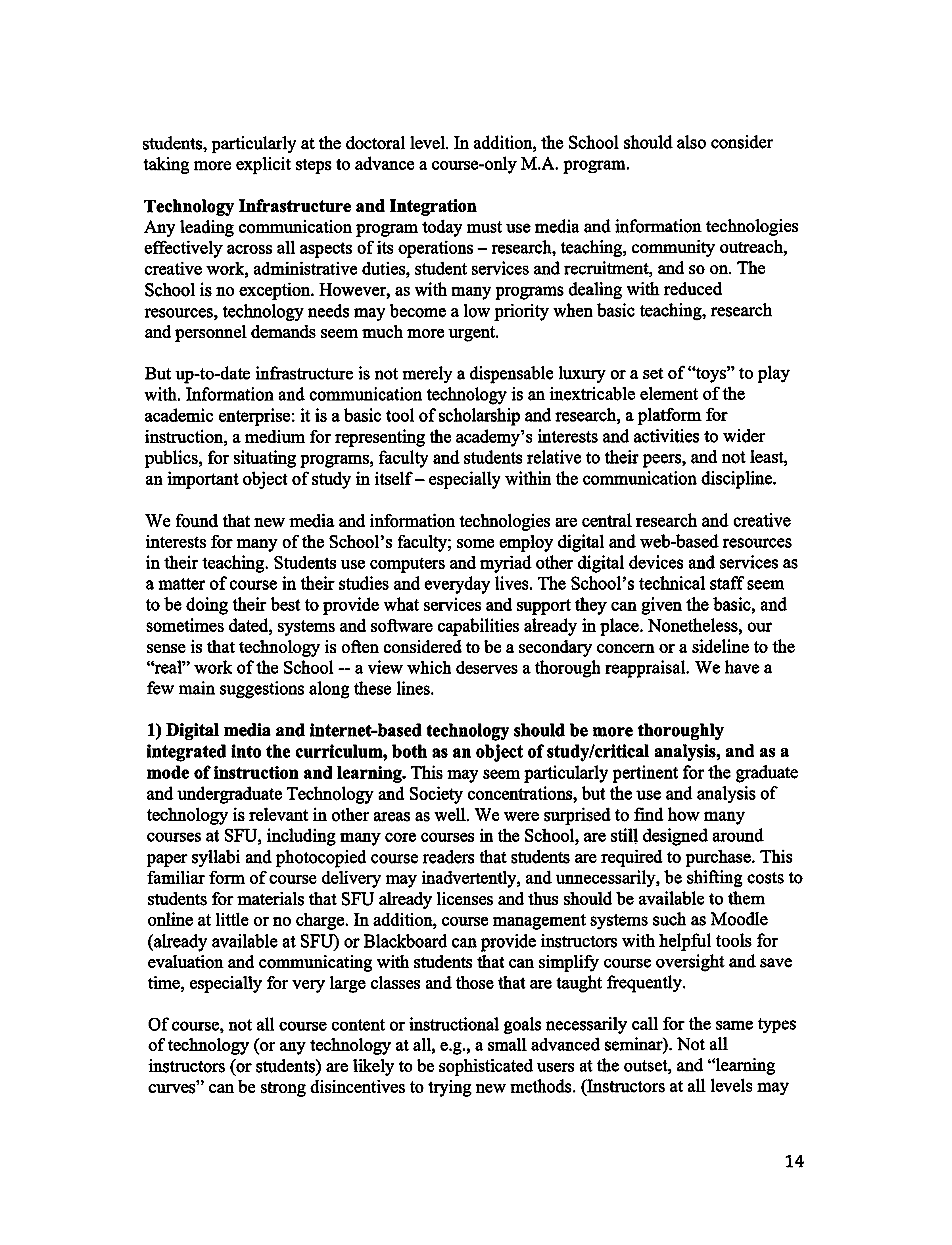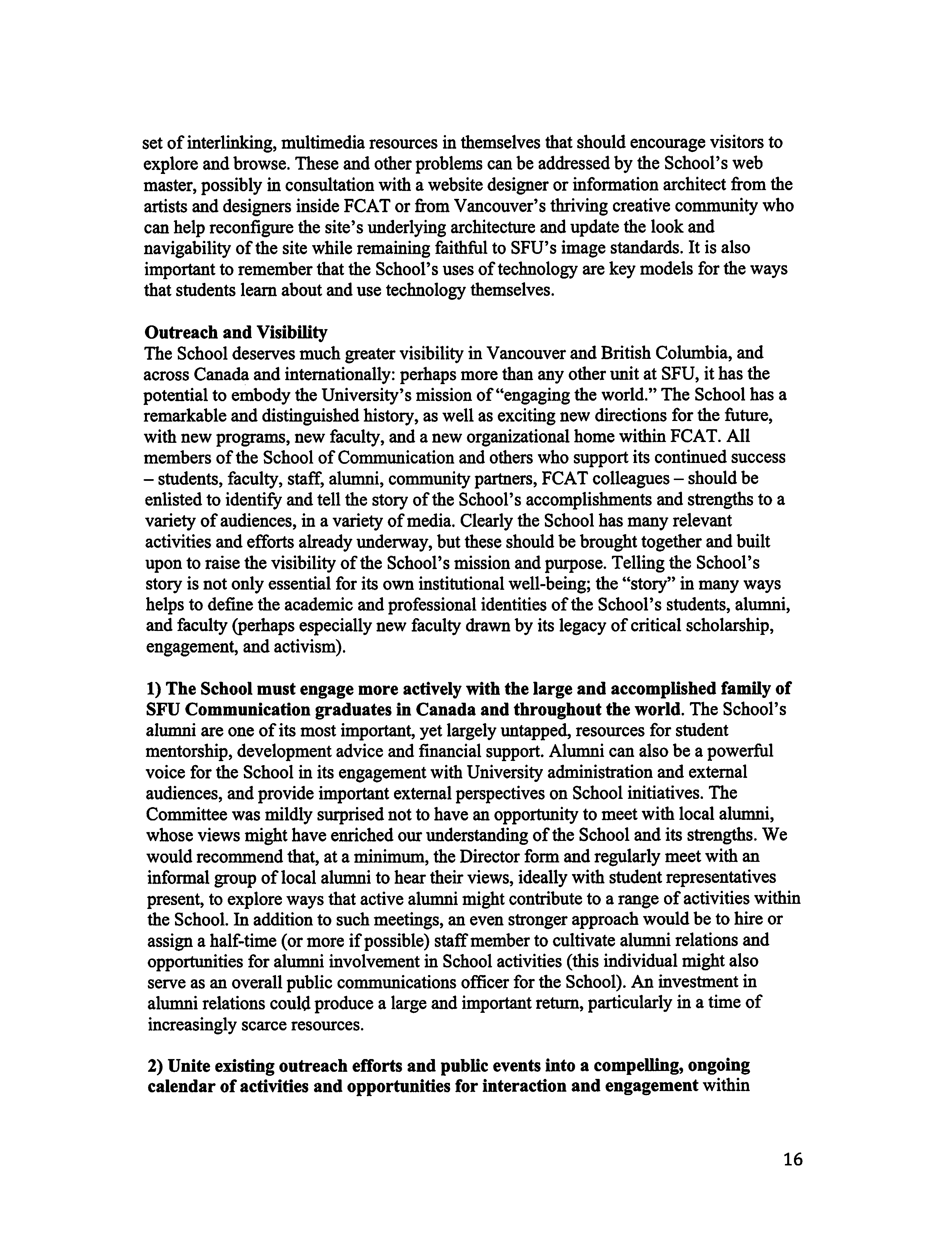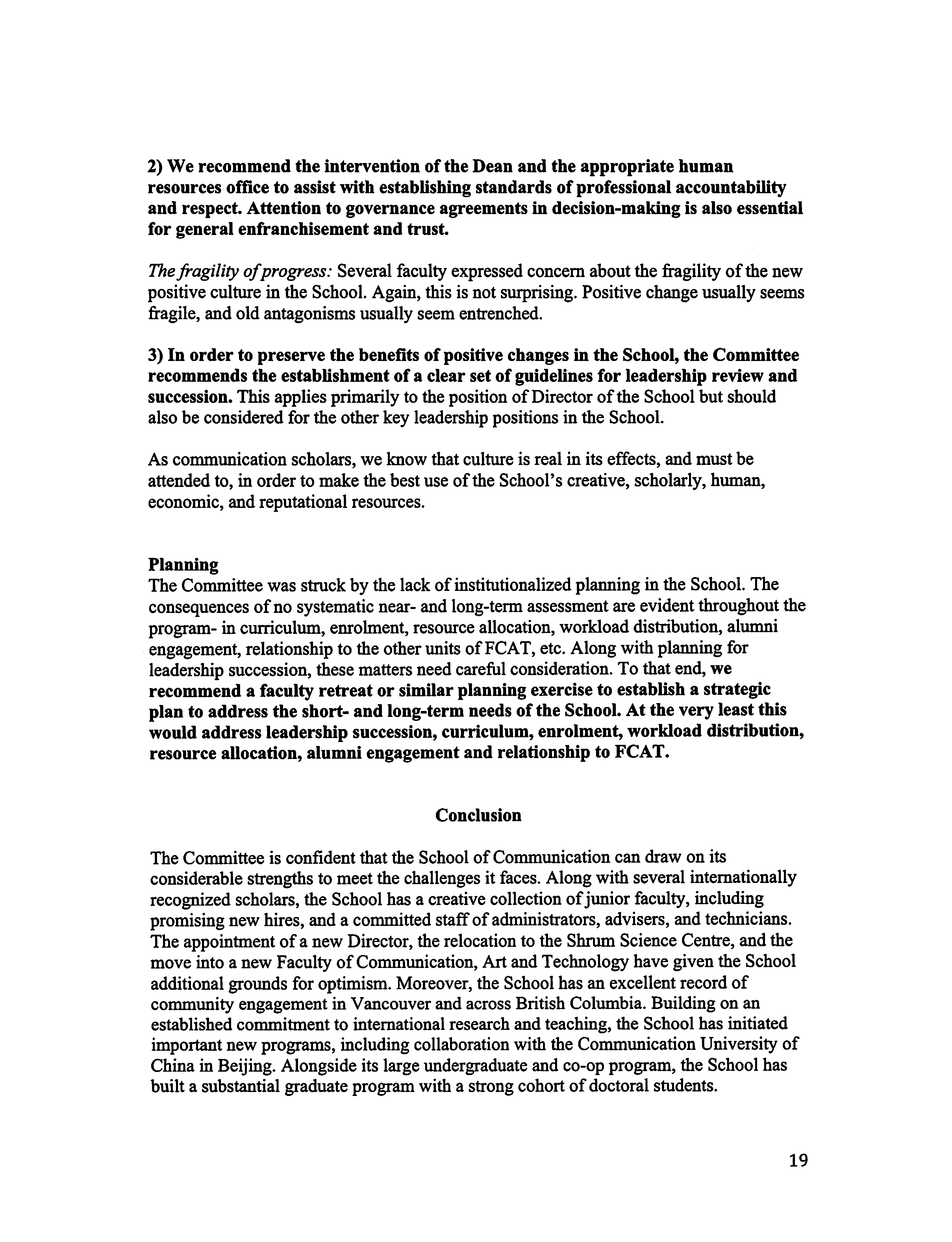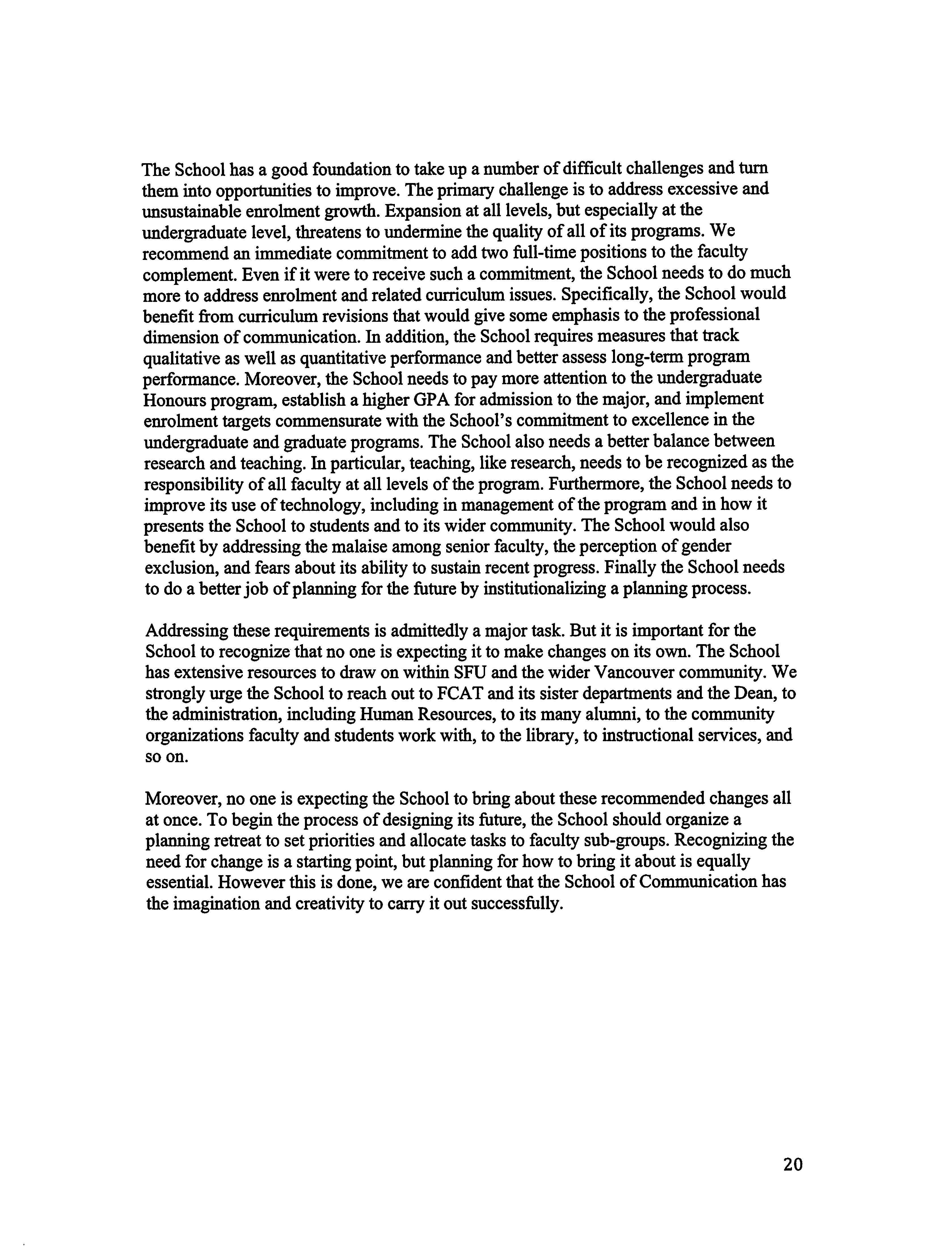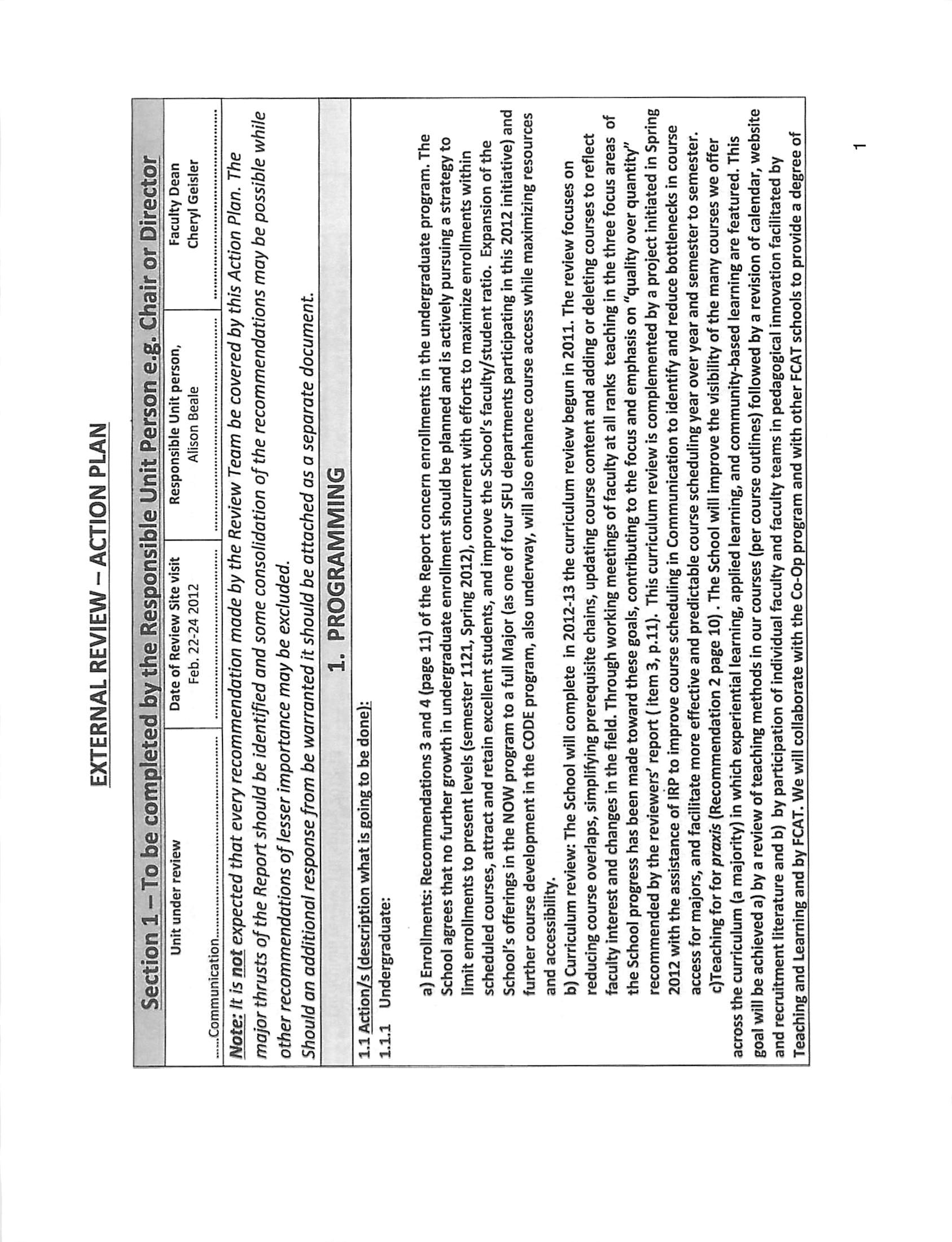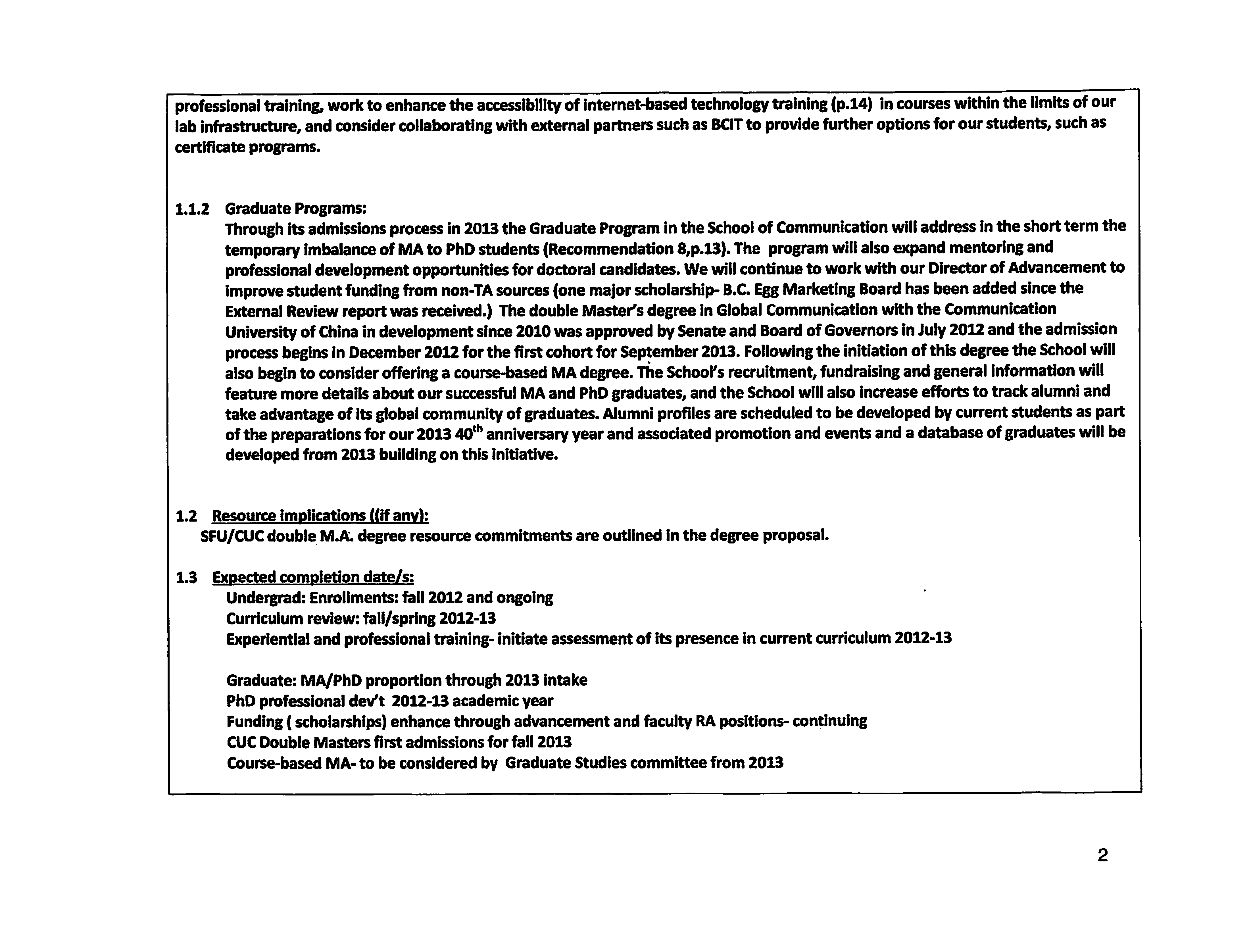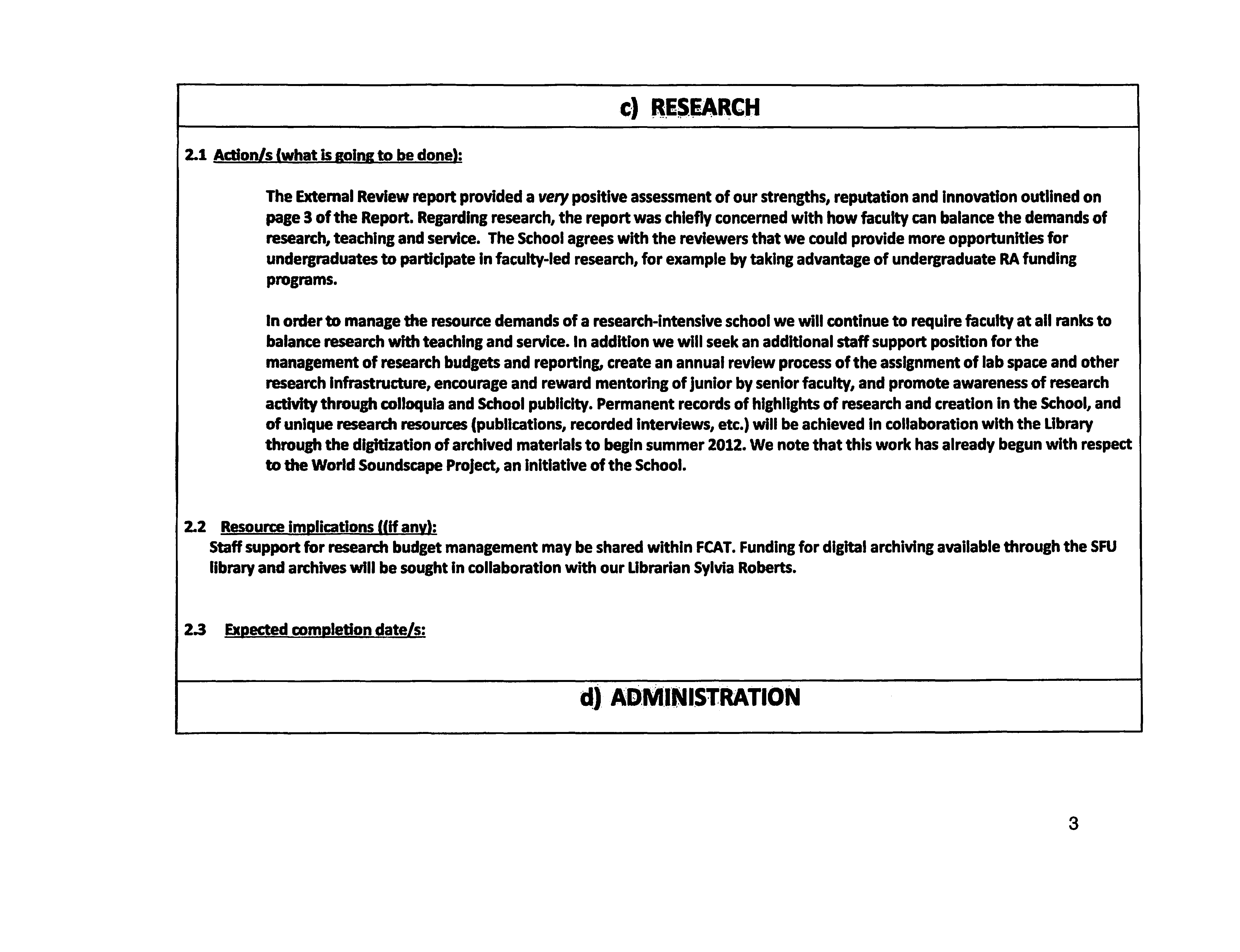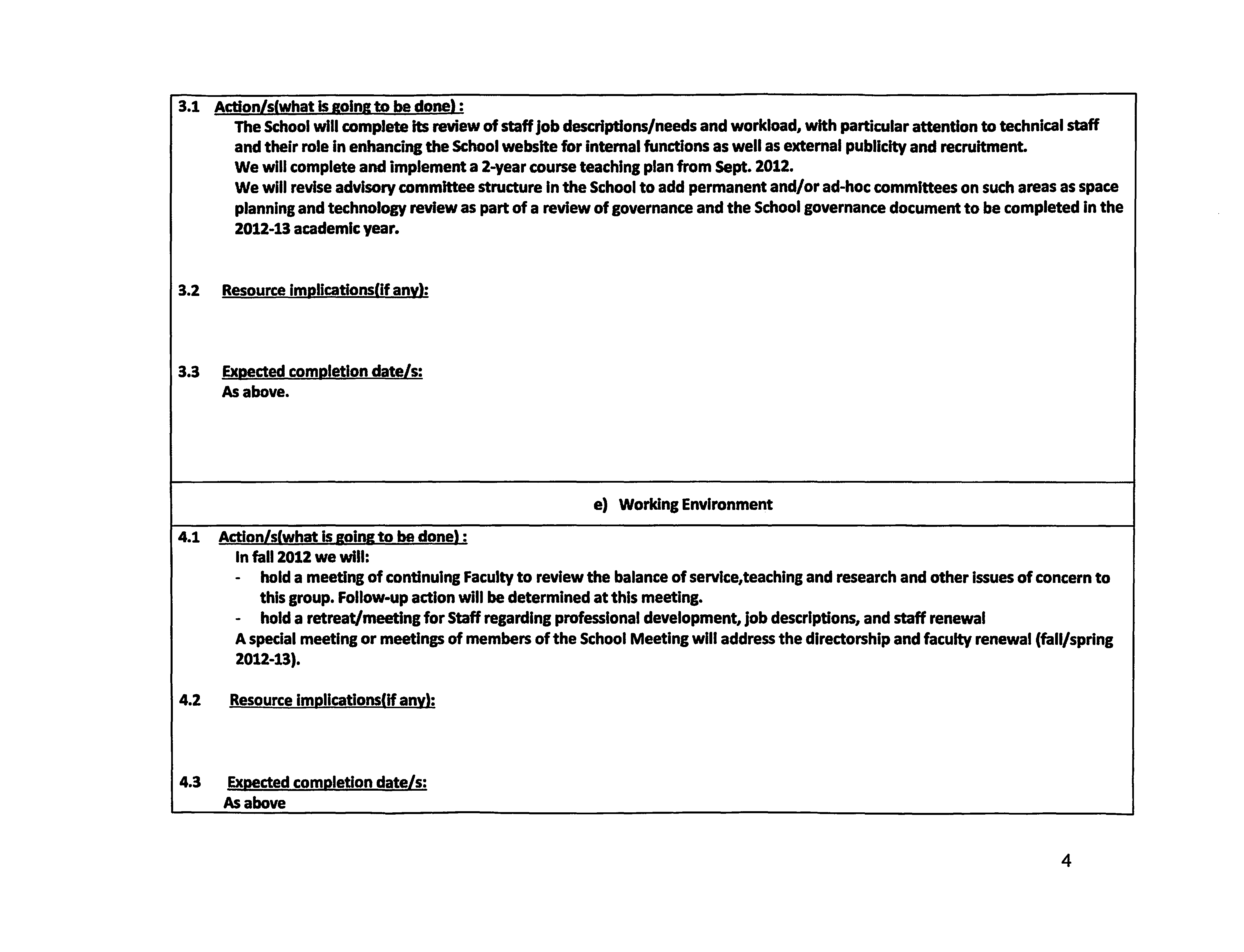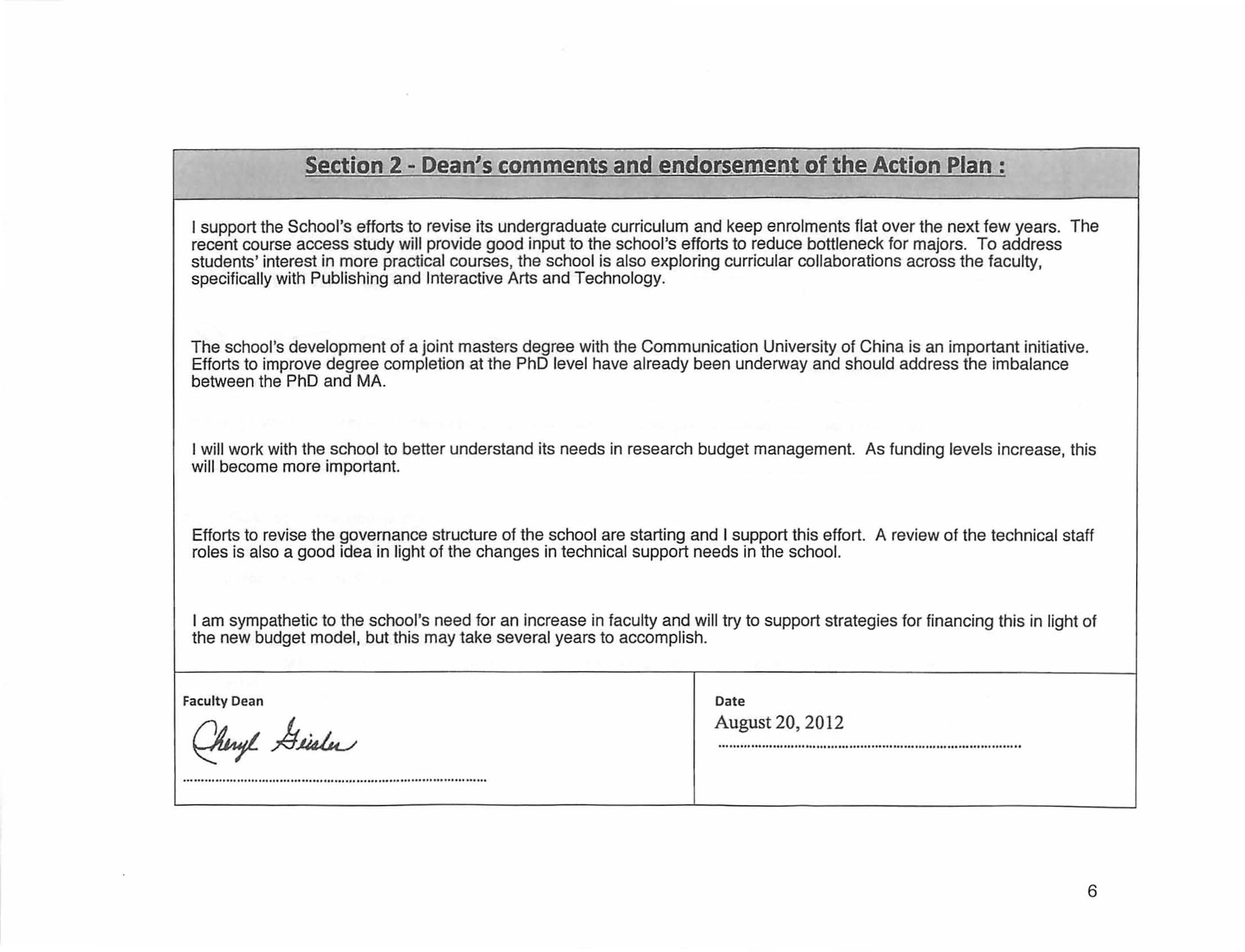S.12-142
SFU
OFFICE OF Till- VICE-PRESIDENT, ACADEMIC AND PROVOST
University Drive, Burnaby, BC
Canada \'5A 1S6
TH1.: 778.782.3925
FAX: 778.782.5876
www.sfu.ca/vpacademic
MEMORANDUM
attention
Senate
DATE
September 12,2012
FROM
Jon Driver, Vice-President, Academic and
PAGES
1/1
Provost, and Chair, SCUP
RE:
Faculty of Communication, Art and Technology: External Review of the
Communication (SCUP 12-31)
At its September 5, 2012 meeting SCUP reviewed and approved the ^ctioq Plan for the School for the
Communication that resulted from its External Review.
Motion:
That Senate approve the Action Plan for the School for the Communication that resulted from its External
Review.
end.
c:
A. Beale
C. Geisler
SIMON FRASER UNIVERSITY
ENGAGING THE WORLD
SFU
SCUP 12-31
OI-TICl- OPTTIE VICE-PRESIDENT, ACADEMIC AND PROVOST
8888 University Drive, Bumaby, BC
TEL 778.782.6702
gokho11@sfu.ai
Canada VSA 1S6
www.sfb.ca/vpftcademic
MEMORANDUM
attention
Jon Driver, Chair, SCUP
date
August 23, 2012
FROM
Bill Kranc, Associate Vice-President,
pages
1/1
Academic and Associate Provost
RE:
External Review of the School ofCommunication
/)
I /Js
Attached are the External Review Report on the School of Communication and the Action Plan endorsed
by the School and the Dean.
Motion:
That SCUP approve and recommend to Senate the Action Plan for the School of
Communication that resulted from its External Review.
Following the site visit, the Report of the External Review Team* for the School of Communication was
submitted in April 2012.
After the Report was received, a meeting was held with the Dean, Faculty of Communication, Art and
Technology, the Director of the School of Communication, and the Director of Academic Planning and
Budgeting (VPA) to consider the recommendations. The School then preparedan Action Plan based on the
Report and these discussions. The Action plan was then submitted to the Dean who endorsed it.
The Reviewers commented that "The School of Communication at Simon Fraser University is a well-
established, intellectually innovative center for communication research and teaching. The School boasts
internationally renowned scholars in the areas
of political economy/policy and in technology and society".
The Reviewers made a number
of recommendations covering the agreed Terms of Reference.
SCUP recommends to Senate that
the School of Communication be advised to pursue the Action Plan.
Attachments:
1. External Rev iewReport-Apri12012
2. School of Communication - Action Plan
* External Review Team:
Dr. Vincent Mosco (Chair), Queen's University
Dr. Lisa Henderson, University of Massachusetts, Amherst
Dr. Leah Lievrouw, University of California, Los Angeles
Dr. Marjorie Cohen (Internal), Simon Fraser University
CC
Cheryl Geisler, Dean, Faculty
of Communication, Art and Technology
Alison Beale, Director, School of Communication
SIMON FRASER UNIVERSITY
ENGAGING THE WORLD
Report of the External Review Committee for the School of Communication at
Simon Fraser University
Submitted to:
Dr. Glynn Nicholls, Director, Academic Planning & Budgeting, Simon Fraser University
Submitted by:
Dr. Vincent Mosco (Chair), Emeritus Professor of Sociology, Queen's University
Dr. Lisa Henderson, Professor of Communication, University of Massachusetts, Amherst
Dr. Leah Lievrouw, Professor of Information Studies, UCLA
April 12,2012
Executive Summary
The School of Communication at Simon Fraser University is a well-established,
intellectually innovative center for communication research and teaching. The School has
internationally recognized strengths in the areas ofpolitical economy/policy and in
technology and society, as well as burgeoningrecognition in cultural studies and
particularly in feminist scholarship. In additionto a number of renowned scholars, the
School has a committed group ofjunior faculty, including new hires, and an equally
dedicated staff ofadministrators, advisers, and technicians for its academic and co-op
programs. The appointment ofa new Director, alongwith the organizational move into a
new Facultyof Communication, Art and Technology and the physicalrelocation into
much-improved facilities havebrought a renewed sense of optimism. In addition, the
School can be proud of its community engagement in Vancouver and across the province,
as well as a strong commitmentto international researchand teaching, most recently in
Asia. Alongside its large undergraduate and co-op program,the School includes a
substantial graduate program with a strongcohort
ofdoctoral students.
These strengths provide the School witha good foundation to takeup a number of
difficultchallenges. Foremostamongthese is the need to address unsustainable
enrolment growth and, relatedly, to make a number of curriculum reforms. Enrolment
expansion at all levels,but especially at the undergraduate level,threatensto undermine
the quality of all of the School'sprograms. We recommend an immediate commitment to
add two full-time positions to the facultycomplement. Even with this, much more needs
to be done to address enrolment and curriculum issues. We recommend curriculum
revisions that would better balance the academic and the professional dimensions of
communication. In addition, the School needs to create measures that track qualitative as
well as quantitative performance and better measure long-term program performance.
Moreover, the School needs to strengthen the undergraduate Honours program, establish
a higher GPA "gate" for admission to the major, and implement enrolment targets at both
the undergraduate and graduate levels commensurate with the School's commitment to
educational excellence. The School also requires a better balance between research and
teaching. Like research, teaching needs to be recognized as the responsibility of all
faculty at all levels
ofthe program. Furthermore, the Schoolneeds to improve its use of
technology throughout the program, including how it manages the program and presents
itselfto students and to its wider community. The School would also benefit by
addressing problems in its climate or culture. These includemalaiseamong senior
faculty, the perception of gender exclusion, and fears about the abilityto sustain the
School'srecent
progress. Finally, the School needs to do a betterjob of planning for the
future.
These are substantialchallengesbut we are confident that the School has the ability to
address them with intelligence and creativity.
Introduction
This is the report of the External Review Committee for the School of Communication at
Simon FraserUniversity. The Committee was comprised of Dr. Vincent Mosco, Chair,
Emeritus Professor of Sociology, Queen's University; Dr. Lisa Henderson, Professor of
Communication, University of Massachusetts, Amherst; and Dr. Leah Lievrouw,
Professor of Information Studies, UCLA. Dr. Marjorie Cohen, Professor of Political
Science at SFU served as an internal member of the Committee for the duration of its site
visit and the Committee is very grateful for her generous assistance throughout the
process.
The Committee was constituted in the fall 2011 and was provided with documents to
review about the School
of Communication, the Faculty of Communication, Art and
Technology, and Simon Fraser University about one month before members visited the
University. The site visit took place from February 21-25, 2012. The Committee met for
the first time on the evening of February 21 to get acquainted and discuss its itinerary and
terms of reference. From February 22-24 it met with faculty, undergraduate and graduate
students, and administrators in the School and in various administrative units at SFU. The
Committee provided preliminary impressions from the site visit to the Director of the
School and then to a group
of senior administrators on February 24. On February 25 the
Committee met to discuss it findings and plan this written report.
Strengths
The School of Communication at Simon Fraser University is a well-established,
intellectually innovative center for communication research and teaching. The School
boasts internationally renowned scholars in the areas of political economy/policy and in
technology and society. The former include particular expertise in the study of media
corporations, government policy-making (including cultural policy formation), media and
social movements, media democracy, and international communication. Moreover, the
School has considerable strength in both the conceptual understanding of the relationship
between technology and society and in the empirical study
of technology, especially in
the areas
of health and science. The School has burgeoning strengths in cultural studies
and particularly in feminist scholarship. The combination
of seasoned scholars and new
hires has the potential to turn this area into a field of international recognition.
One of the particularly positive signs for the School has been the ability to make a
number of important and successful hires at the junior level. It is clear that it has not had
the resources to hire sufficiently to replenish its complement, particularly in light
of the
significant growth in undergraduate enrolment. However, new
and more seasoned junior
faculty have been a source of considerable strength and continuity in each of the School's
primary areas of specialization. The School also appears to have a strong tutorial system
that brings together teaching assistants and undergraduates.
The School has a tradition of research relationships beyond Canada, particularly with
scholars and policy makers in the United States. It has recently established a strong base
ofinternational commitments, notably in Asia. Foremost among them is the
establishment of a joint graduate program with the Communication University ofChina
(CUC) in Beijing. More than an exchange of graduate students, the programwill enable
participants to pursue a rigorous joint degree mat is sureto enrich SFU's already strong
MA in Communication Studies. The CUC is one ofthe foremost communication studies
programs in China and sufficient preparation is underway to build on the joint teaching
program with research collaborations. Since the programhas only just been approved, it
is important to closely monitor its development. In addition to this program, the School
has taken advantage
ofanother faculty appointment to expand its research profile into
Korea, a major centre for communication research in Asia.
From our observations, the School has a dedicated staff of administrators, advisers, and
technicians for its academic and co-op programs. Consideringthe sheer number of
undergraduate majors (roughly 1300) co-op participants (about 350) and graduate
students (over 80), it is remarkable that the program manageswith its limited number
of
staff. It is evidence of everyone's hard work and commitment but one wonders for how
long the staff can manage without additional personnel.
Although precise data are not available, interviews and knowledge ofuniversityprograms
in Canada provide evidence thatPhD program graduates find positions in distinguished
academic programs and in academic leadership roles across Canada.
We observed a strong
espritde corps
among junior andrecently-tenured faculty who
have taken on the
challenge of leading key committees, initiating reforms in the School's
decision-making processes, and managing undergraduate courses whose enrolments have
increased substantially in recent years. This is especially the case among core
undergraduate courses, but it canbe observed throughout the curriculum. It is particularly
positive to note the commitmentofjunior and recently tenured faculty to the
responsibilities of collaborative governance. Thisis especially evident in the
undergraduate program committeebut canalso be observed in the graduate program
committee.
The appointment ofa new Director has introduced a climate of possibility in the School.
Specifically, although concerns remain about the process of succession, mere is a general
feeling in the School, especially among newly appointed and recently tenured faculty,
that there is a renewedandmuch-neededcommitment to transparent processes, collegial
governance, and gender equity.
Althoughthe Committee did not have opportunities to talk to many undergraduates,
interviews with undergraduate leaders, faculty, and staff associated with the program
suggest that undergraduates have a solid affinity withone another and withthe program.
While they would like to see amore applied communication focus intheundergraduate
curriculum, there is an appreciation ofthequality of teaching, particularly in the areas of
program concentration: media culture, technology and society, and political
economy/policy.
A key reason cited for general undergraduate satisfaction is a well-managedco-op
program. Withparticipation from aboutthirtypercent of majors, the co-opprogram
placesstudents in paid positions in jobs that are generally relatedto the field of
communication. Although systematic data on career outcomes is not available (see
recommendations), anecdotal evidence leads to the conclusion that the program has
helped graduates find employment after completingthe degree.
Faculty and students in the School are engagedin a wide range of community outreach
activities including, but certainly not limited to, leading the annual Media Democracy
Day event, contributing to community knowledge production, and participating in the
wider community'seffort to expand communication and better manage environmental
risk and disaster. The School'sinvolvement in a variety of British Columbia commumties
is certainly noteworthy for the depth and breadth of its reach. However, information
about community engagement is rarely communicated to the university'svarious
constituencies.
Over the years, the School has built an impressive set ofarchives. These include the
papers of Dallas Smythe, a central figure in the development of communication studies,
particularly the political economy approach to the media. Smythe was a vital force in the
early development ofthe School of Communication. In addition, under the direction of
Professor Barry Truax, the School holds the SoundScape collection, which is a type of
electroacoustic music characterized by the presence of recognizable environmental
sounds and contexts whose purpose it is to invoke the listener's imagination and
recollections associated with the soundscape. There is also a notable archive on
alternative media, particularly on media developed in British Columbia. Much more
could be done to preserve and make readily accessible these rich resources. The library
liaison for the School of Communication, whose interview impressed our committee, is
keen to work on this important task.
Two relatively recent relocations, one physical and one organizational, are also sources of
renewed strength for the School. First, the relocation of the School to the Shrum Science
Centre is a major improvement in the size and quality of the office space and available
facilities. With this location and the Harbour Center campus, where 40%
of courses are
now taught, the School is well situated to carry out its teaching and research.
Nevertheless, given the size of the graduate cohort and anticipated expansion, attention
needs to be paid to office space for doctoral students. Second, organizational
restructuring has placed the School in a new Faculty of Communication, Art and
Technology (FCAT). The reorganization provides a considerably more appropriate
location for the School than its previous position within a Faculty
ofApplied Sciences.
Although it is too soon to determine whether genuine collaborations will emerge between
units in the faculty, there is considerable potential for these to develop.
Challenges and Opportunities
Enrolment and Curriculum
The Committee's view - consistently reinforced by faculty, students, and administrators
as well as by the recommendations from the previous review - is that the single most
serious challenge facing the School ofCommunication is the size ofits academic
programs relative to available resources. Recent enrolment growth, especially at the
undergraduate and Ph.D. levels, has generated a web
of significant, interrelated, and
negative consequences for virtually every aspect ofthe School's operations. The situation
is frankly unsustainable.
Background
and scope.
Exact figures for enrolment trends were a bit difficult to
determine, given data comparability issues in the materials provided
by the University
and the School (e.g., some reports employed annualized student FTE in their analyses,
some used registered students, some total headcounts, etc.). However, a rough estimate
provided by faculty during our visit is that there is currently a total ofabout 1300
registered undergraduate FTEs in Communication, up from 1200 reported
by the
University in Spring 2010 (roughly an 8% increase in less than two years). According to
the School's Self-Study, the number ofundergraduate majors increased by approximately
30% during the period
ofthe present review (AY 2004-05 through 2010-11), including a
particularly steep rise ofmore than 36% in the six years from Spring 2005 to Spring
2011. After the last external review, the minimum GPA for admission to the major was
raised from 2.25 to 2.50,
but this seems to have done little to stem the steadily rising tide
of enrolments.
The proportion ofundergraduate Honours majors is surprisingly low; in 2010, just 9 of
1128 majors (.0079%) were Honours students. Despite the undergraduateprogram's
focus on theory and research, faculty report that only about 2-3%
ofCommunication
B.A.s continue to graduate academic study or professional programs. Some claimed that
this rate reflects the School's vision that students should be prepared to "navigate
citizenship in a media-dense, global, multiculturalworld" (as quoted in the
Undergraduate Curriculum Committee Report from 2010). One interviewee put it more
bluntly: "we teach for citizenship, not
graduate school." There were some anecdotal
reports of problems with academic integrity(plagiarism) arising from degree completion
and employment pressures. According to data included in the Self-Study Report,
persistent demand for courses amongboth majors andnon-majors has led to a shortage of
seats in required courses; as of2010 undergraduate time to degree was nearly five years.
An increase in the number ofregistered undergraduates with international visas appears
to be animportant factor contributing to enrolment growth. According to University
figures, international students accounted for about 10%ofcommunication
undergraduates between2004and 2009, but thenrose sharply to 13% in Spring 2010 and
nearly 17%in Spring 2011. Accordingto the Self-Report, that figure is now about22%,
andhas
already raised significant issues for instruction and advising, includinglanguage,
culture, and student life issues.
In addition to the undergraduate population, the School enrolls over 80 graduate students
atallstages of progress, with a fairly high ratio of Ph.D. students to M.A. students (54 of
83.5, or over two-thirds, in University figures from 2010). To some extent the large
population of doctoral students may be the product of increasing time to degree rates,
which, according to the Self-Study Report, averaged nearly 18"active" (registered)
semesters, or six years, during the present review period, a figure which does not include
terms when students are on leave or working independently. In interviews, doctoral
students attributed time to degree problemsto their large teaching loads; most financial
support for doctoral students takes the form oftemporary employment asteaching
assistants, sessional or limited-term instructors, who staffthe School's own
undergraduate courses.
Currently the School has a faculty complement of24.5 FTE, up from 21.5 in 2010. In
2009-10,the faculty-student ratio in the School was 1:48.2, among the highest in the
University, comparedto an average of 1:29.8 for SFU as a whole and 1:36.1 for FCAT.
Figures from the School's Self-Study indicate that the ratio improved modestly, to 1:43.8
in 2010-11 (about a 10% decrease), which may be attributable in partto two new tenure-
track faculty hires. It remains the highest in FCAT. Moreover, the decline was still less
than a University-wide drop
ofnearly 15%, to 1:26, during the same period.
In an attempt to address the growing enrolment problems, the School establisheda new
Undergraduate Curriculum Committee (UCC) during the currentreview period. It was
charged with finding ways to rethink and restructure the curriculum to bring it into line
with the School's resources. In June 2010 the UCC conducted a faculty curriculum retreat
and issued a report with preliminary recommendations for taking constructive steps
toward goals identified in the retreat. These included the streamlining and re-focusing of
the number and content of courses; reducing enrolments by raising standards for
admission to the major; and updating course information online to make it conform to
actual syllabi and course content.
During our visit, this report was consistently hailed as a turning point by faculty, staff and
graduate students. Unfortunately, however, more recent progress reports from the UCC
and our conversations during the visit indicate that action on the 2010 recommendations
has been slow in coming.
As of January 2012, titles and/or descriptions of 13 courses (out
of a total catalog ofroughly 75 undergraduate-numbered courses, not including special
topics courses) have been revised and posted on the university Calendar. Proposed
changes to 14 other courses have either been rejected outright or returned to faculty
subcommittees for further discussion. Meanwhile, as noted in Appendix B ofthe UCC
report, the School offers more courses than any ofits comparison programs in North
America, and maintains a larger catalog ofcourses than its rivals. (Even the School's
Self-Study Report describes the undergraduate curriculum as "expansive.")
One existing course (CMNS 200) - which, perhaps ironically, was among the most
popular with students because of its focus on effective communication skills —has been
eliminated on the grounds that faculty are unavailable to teach it. A proposal for an
FCAT-wide introductory course on new media, informally dubbed "Tech One," which
would have integrated theory, design, and digital media competencies, was rejected
by
Communication faculty because ofits focus on technology rather than on social science
research. In December 2011 faculty participating in the three major areas
ofthe
undergraduate curriculum (political economy and policy, media and culture, and
technology and society) met to discuss curriculum content and structure for each area;
one group (technology and society) drafted a new areadescription. As noted above,
undergraduate enrolment has continued to increasesince the report was issued.
In sum, despite the sense
of urgency about ballooning undergraduate enrolment expressed
by virtually everyone during our visit, there seems to have been little substantial progress
since the last review to put measures in place that might begin to remedy the situation.
Instead, faculty and staff seem to be nearly overwhelmed just dealing with the demands
of the existing program. The complexities of setting the course schedule and faculty
teaching assignments have been largely delegated to administrative staff, who
understandably tend to replicate the established schedule year after year, or as one
member put it, "pretty much hit the repeat button." A relatively large proportion of all
CMNS courses (one interviewee estimated 25%) are cross-listed between the
undergraduate and graduate programs, so that they do "double duty" with scarce
resources.
But cross-listing has also led to a lack of a dedicated core curriculum for the
Ph.D. and an unfortunate situation for graduate students who sit in the same classrooms
with undergraduates
who are their pupils in other courses.
Faculty, staff and students offered various anecdotal explanations for this seemingly
intractable situation. Some cited large and unreasonable enrolment expectations from
university administrators,
who are thought to see the undergraduate Communication
program as a source of revenue generation. (In fact, administrators confirmed that the
School's budget is "revenue-driven," with student fees a key component.) As one faculty
member put it, "The University thinks of us as a 'bums-in-seats' program." Another said
that the administration would often "open the floodgates," creatinglast-minute sections
for popular courses and unanticipated staffing shortages, while prohibiting the School
from setting its own enrolment levels. A few cited increasing pressures from the
University to enrol a greaterproportion of international students, who are more likely
than domestic students to meet the School's admission requirements, pay considerably
more than the rate of domestic undergraduate tuition, but also require more remedial
instruction and advising support. Some graduate students attributed the slow pace of
change to resistant faculty, saying that there was "little traction" among faculty on the
undergraduate proposals after the 2010 retreat.
In our own exploration of the issue,we found what appear to be common attitudes within
the School toward different modes of knowledge creation and learning which may also
act as barriers to change. Although "hands-on" courses and production are described on
the School's website as majorfeatures of study at SFU, a number of faculty tended to
cast research/scholarship and creative work/practice (e.g., media production, digital
technology design and use, community engagement and activism) as opposing or even
antithetical pursuits. The first was intellectually valorized and privileged, while the
second was often dismissed as secondaryor even anti-intellectual. Several faculty
specifically excluded any suggestion that the program should increase its focus on "media
practice" in the core curriculum, contending that such courses dilute the School's primary
focus on theory and research, and that skills courses are better handled by local colleges
or postgraduate certificate programs.
A second, and related, attitude among many of those we spoke with is that research and
teaching are competing activities in a zero-sum relationship: effort directed toward
teaching is seen as taking time and effort away from more prestigious and rewarding
research activities, and vice-versa. This view has had a clear influence on the curriculum.
Many senior faculty with active research projects or administrative responsibilities
receive substantial, and perennial, teaching releases. Some are either unwilling or
unprepared to teach introductory undergraduate classes and instead concentrate their
teaching efforts on small, specialized upper-division courses and graduate seminars.
Although the UCC Report notes that the School "can offer students exposure to the work
of advanced researchers and leading experts in many areas of Communication Studies," it
also concedes that with full time (tenure-stream) faculty teaching just 16% ofthe
School'scourses in 2009, "Students have limited contact with full time faculty, especially
at the lower levels."
Responsibility for the largest introductory and required courses has largely been shifted
to junior and recently tenured faculty, especially to sessional and limited-term instructors
drawn from the ranks of the School'sown doctoral graduates and graduate students.
Statistics compiled for the 2010 UCC report1 bear this out. They suggest that between
2004-05 and 2009-10 the number of lower-level undergraduate courses taught by
sessionals roughly doubled, while the number taught by full-time faculty fell, with the
steepest change occurring after 2007. Although the differences were not as pronounced
for upper-division courses, the trend was broadly similar; by 2009-10 (the most recent
data available), sessional instructors were teaching substantially more undergraduate
courses overall than full-time faculty. This redistribution trend seems to be strongly
supported by the tenure-stream faculty: the UCC Report even floated a suggestion that
the School consider creating a new, teaching-only tier of full-time faculty lecturers so that
senior researchers might continue to be sheltered from extensive undergraduate teaching
responsibilities. Indeed, one interviewee thought it unlikely that senior faculty who are
already unwilling to teach lower division courses could be "rehabilitated," i.e., persuaded
to teach such courses in the future.
We offer the following recommendations to address enrolment and curriculum issues.
1) Increase the number of full-time faculty in the School of Communication.
We recognize the attraction and energy of a Communication program and the reputation
that Communication has in sustaining student interest. It is widely understood as a
cutting-edge field, a liberal arts alternative, and a flexible major for students whose
interests are in formation and whose ambitions lead them to currently popular professions
1Three graphs using the same titles and data labels appear inboth Appendices Band D ofthe 2010 UCC
report
(200-leveI Course TeachingDistribution,Lower-level Course TeachingDistribution,
and
Upper-
level Course TeachingDistribution).
Although they show the same basic trends, there is some
inconsistency in the data between the versions presented in each Appendix. Therefore only the trends are
discussed here.
and pursuits. It is one of the few disciplines in the liberal arts and social sciences
experiencing growth in relevant academic and non-academic fields. One can easily
understand the demand for undergraduate and graduate programs in the field. However, if
the administration of the university chooses to continue to permit this growth then it must
increase the faculty complement in the School or suffer the erosion of program quality at
all levels. At the very least, it needs to add two new full-time positions to the School with
this net increase to the faculty complement in place by the start
of the 2015 academic
year. The failure to provide sufficient faculty will continue to exacerbate a series
of
problems. Undergraduate over-enrolment relative to faculty resources inflates class size;
dramatically reduces faculty/student contact; limits essential, labor-intensive forms of
instruction and evaluation that faculty, students, and University leaders value; and
entrenches a work environment
of overextension and precarity for students, faculty, staff,
and advisors. Recognizing the pressures on the University from reduced provincial and
institutional budgets, we do not make this recommendation lightly. The School faces a
clear threat to its well-earned reputation brought about by enrolments spiraling out
of
control. We also recognize that several steps in addition to enhanced resources must be
taken to address the curriculum and enrolment challenges it faces.
2) Prepare students for life after SFU, whether professional or academic.
Understandably, anxious students facing an uncertain postgraduate job market tend to
demand instruction that centers on simple skills training rather than critical engagement
with important ideas and debates, the latter
of which has been SFU's traditional_/brte. But
addressing such learning needs need not mean funneling scarce resources into expensive
"hands on" media production courses and tracks. The School's historical commitment to
progressive values - critical thinking, political and economic equity, social justice,
community engagement - provides an ideal scaffolding for the integration of theory,
research, and critical scholarship with pedagogies that require students to take action and
use their knowledge to advance these values in the communities they care about: in short,
teaching for
praxis.
In addition to rigorous critique and written communication skills, a short list of relevant
competencies in a
praxis-centered
curriculum might include media analysis (the mastery
and application of critical literacies, e.g., in effective alternative message design), public
presentation and advocacy across media platforms, negotiation and group communication
skills, risk and conflict intervention, critical technology assessment, advanced search and
information/content evaluation, policy scenario building, critical data visualization, and
so on.2 Few of these would necessarily entail major capital investment, but certainly
community organizations, government agencies, cultural institutions, trade unions, and
private-sector firms who value these competencies in SFU's Communication graduates
could be approached to underwrite scholarships, intensive workshops, specially-equipped
classrooms, and so on to support /?7"am-driven teaching.
2Theexpansion ofcritical media literacies and pedagogies is thefocus of several major communication-
based researchprograms. See, for example, the
Learning Through DigitalMedia
in New York City, headed by Trebor Scholz (http://www.learninizlhroiighdigitalmedia.net/) and the
New
MediaLiteracies Project
at the University of Southern California, headed by Henry Jenkins
(http://dmlcentral.net/resourccs/3756 ).
10
It is important to point out that the seedsof this approach alreadyexist withinthe School
and FCAT. The Minor in Dialogue, for example, could be a point of departure for
teaching and learning about negotiation, intervention, and group process. The co-op
program, which by all accounts is extraordinarily effective, has a strong record of
mentorshipand engaging students in the community during their studies and in
subsequentpostgraduateplacements. A closer integration
of co-op into the curriculum,
including more required student involvement and granting course credit for co-op
activities, would go a long way toward cultivatingthe spirit of
praxis
in teaching and
learning in the School. In addition, relevant integrated (theory-action) pedagogies
certainly already exist within FCAT, for example in art and design courses. The School
would benefit from closer collaboration with its sister units to develop innovative, cross-
cutting pedagogies.
3)
The criteria for evaluating program success should shift from an emphasis on
quantity and "throughput" and toward a primary focus on excellence in all aspects
and modes of teaching and learning, to achieve an enrolment level commensurate
with major requirements and available resources.
The popularity of an academic
program is not always a good indicator of its intellectual merit or predictors of student
achievement or success. This is especially true for fields like communication, whose
association with popular media culture may attract generalist students or those seeking
alternatives to more rigid disciplines like business or psychology. A reliance on
capitation as the principal measure ofprogram strength, and the concomitant idea that
any single academic program can offer "something for everyone," only encourages
inflated enrolments, the accretion of outdated courses and content, and a reluctance to
prune courses or concentrations as necessary to keep up with changes in the field and
(more critically) faculty expertise. Any faculty must decide what types
of graduates they
want to produce, in specific terms ofknowledge, values, attitudes and practical skills;
then they must design coherent, uncluttered, non-redundant curricula and pedagogies that
make those types
of learning possible. A shift from quantity to quality will necessarily
entail considerable effort and commitment from every active member of the faculty.
Once established, however, a focus on excellence will transform the academic and
research climate ofthe School and provide ample justification for maintaining enrolments
at a level more in keeping with full-time faculty workload.
4) Clear, consistent, long-term measures of program performance and student
outcomes should be instituted to help manage enrolment over time.
The School (or
university administration, as appropriate) should begin to capture more types of
information that enable them to understand and manage demand for its academic
programs. At a minimum, the School should collect its own data on student placements
(employment or postgraduate academic work), if such data are not provided by the
University. Presently only the co-op program has compiled consistent placement data for
its undergraduate participants. As another example, we received no separate data
documenting the figure of 2-3% ofundergraduates continuing to graduate study that was
cited by several members ofthe faculty.
11
Other useful measures might include annual exit surveys or focus groups of all graduates
to learn more about their experiences in the School and their expectations for the future;
regular, required reporting of graduate student conference presentations, publications,
special awards, orother achievements;3 and frequent reports from advisors (minimum
once per year, preferably each semester) on their students' degree progress, particularly at
the graduate level, to help maintain a consistent and supportive sense of "press" toward
completion.
Once obtained, it is also crucial that relevant data be used to justify and make appropriate
programmatic decisions. For example, the Self-Study Report says that approximately
50% of the School'sdoctoral graduates since 2004 have obtained positions as tenure-
stream faculty at other institutions, as post-doctoral scholars and researchers, as
temporary instructors (many within the School itself), or in other capacities in non-
academic research organizations. It seems reasonable to ask whether any social science-
based Ph.D. program able to place just half of its graduates in academic or related
positions should consider adjusting enrolment to reflect the real market for its graduates.
5)
The undergraduate Honours program should be renewed and expanded as the
exemplar of undergraduate education and achievement in communication studies at
SFU.
An Honours degree is an important distinction that gives recipients a clear
advantage in their future endeavors. Honours students should be prominently recognized
within the School and promoted as part of the School's public profile (see Outreach and
Visibility, below). For a program as research-centeredas Communication at SFU, there
seem to be relatively few opportunities in the current curriculum for bright, motivated
undergraduates to participate meaningfully in rigorous research projects or in-depth
scholarship under close tenure-track faculty mentorship. The Honours program is the
logical avenue for such mentorship and to involve the most highly qualified
undergraduates in research and scholarship. However, as noted previously less than 1%
of Communication undergraduates are Honoursmajors. Eligible students may be
discouragedby the fact that many
of the School's most distinguished faculty appear to be
reluctant to supervise Honours students,due to the workload involved. As a result, the
Honours program was recently converted from faculty supervision and directed study to a
course-based format supervised mainly by temporary instructors. In our view, these are
steps in the wrong direction. To put the Honours programat the center ofundergraduate
study in the School, it is also crucial that Honours advising and mentorship be recognized
and rewarded as an expected and valued part of faculty effort.
6)
The School should implement a consistently high and competitive GPA
requirement for admission to the major.
As the UCC Report rightly observed,the
establishment
ofhigher entrancestandards is one of the quickestand most effectiveways
to manage enrolmentat the undergraduate level,and is clearly suitedto the School's
expectation that students mastertheory andresearch. A higherGPArequirement and
enrolment capwere major
recommendations in the previous review, but as noted
3The listof student publications and presentations included inthe Self-Study Report was an excellent
example, althoughthe Reportnotedthat it was basedon a one-time surveywith a 25% studentresponse
rate.
12
previously raising the GPA to 2.5 has not significantly affected the continued rise in
enrolment. Thus a new GPA requirement (set at a high enough level to cap enrolment
effectively at a target number) is still needed.
Ifnecessary, it could be phased in over
several years in order to have time to shift student expectations and give aspiring
applicants time to meet the new requirements. But in our view new, more rigorous
standards are long overdue, and should be featured and promoted in the School'spublic
communications. Not only would such a move help regulate enrolments; it would also
make the major
more
attractive and increase its cachet among the most talented students,
draw them from a wider range of other fields, and create a larger pool of students eligible
for Honours. In short, the program should move toward new standards and expectations
that will pay off in the form of superb students and higher visibility for the School's
programs and graduates within and beyond SFU.
7)
Research and teaching (especially undergraduate teaching, given its sheer
presence in the School) must be resituated together as essential and expected aspects
of workload for all tenure-track faculty, from the most recent hires to the most
senior professors and CRCs.
The dual demands of research and teaching are the
perennial challenge and conundrum
of academic workload. But in a time ofever greater
resource cutbacks, the balance - indeed, the symbiotic relationship - between research
and teaching must be reassessed realistically so that teaching duties are distributed
equitably, without any derogation ofteaching as a secondary or low-reward activity.
Even if it did not contrast with the School'sprogressive, social equity values, and even if
budget were suddenly available to hire a new rank of full-time lecturers, the creation of a
two-class system would not seem to be the best solution to a situation in which students
already have little opportunity for engagement with the most prominent, senior members
of School faculty.
Top communication programs in North Americacommonlyrequire that all faculty
members teach courses at all curricular levels (lower and upper undergraduate, Master's,
Ph.D.) on a regular two- to three-yearcycle, for example, with releases being the case-by-
case exception rather than long-termrule for the most senior faculty. Moves in this
direction would do a great deal to ameliorate the chronic problems of equitable teaching
load, over-reliance on graduate students and recent graduates as sessional and limited-
term instructors, shortage
of seats in undergraduate courses, and undergraduate and
graduate time to degree problems.
8)
Improve the management of graduate enrolments.
The School enrols over 80 graduate students at all stages
ofprogress, with a fairly high
ratio
of PhD students to M.A. students (54 of 83.5, or over two-thirds, in University
figures from 2010). This is partly the product of increasing time to degree rates for PhD
students, which according to the Self-Study Report averaged nearly 18 "active"
(registered) semesters, or six years, during the present review period, not including terms
when students are on leave or working independently. The School currently admits
between 17 and 25 new graduate students each year, averaging about 20 per year. Absent
new resource commitments, the School should consider lowering its intake of graduate
13
students, particularly at the doctoral level. In addition, the School should also consider
taking more explicit steps to advance a course-only M.A. program.
Technology Infrastructure and Integration
Any leading communication program today must use media and information technologies
effectively across all aspects
of its operations - research, teaching, community outreach,
creative work, administrative duties, student services and recruitment, and so on. The
School is no exception. However, as with many programs dealing with reduced
resources, technology needs may become a low priority when basic teaching, research
and personnel demands seem much more urgent.
But up-to-date infrastructure is not merely a dispensable luxury or a set of "toys" to play
with. Information and communication technology is an inextricable element
ofthe
academic enterprise: it is a basic tool of scholarship and research, a platform for
instruction, a medium for representing the academy's interests and activities to wider
publics, for situating programs, faculty and students relative to their peers, and not least,
an important object of study in itself- especially within the communication discipline.
We found that new media and information technologies are central research and creative
interests for many of the School'sfaculty; some employ digital and web-based resources
in their teaching. Students use computers and myriad other digital devices and services as
a matter of course in their studies and everyday lives. The School'stechnical staff seem
to be doing their best to provide what services and support they can given the basic, and
sometimes dated, systems and software capabilities already in place. Nonetheless, our
sense is that technology is often considered to be a secondary concern or a sideline to the
"real" work of the School ~ a view which deserves a thorough reappraisal. We have a
few main suggestions along these lines.
1) Digital media and internet-based technology should be more thoroughly
integrated into the curriculum, both as an object of study/critical analysis, and as a
mode of instruction and learning.
This may seem particularly pertinent for the graduate
and undergraduate Technology and Society concentrations, but the use and analysis
of
technology is relevant in other areas as well. We were surprised to find how many
courses at SFU, including many core courses in the School, are still designed around
paper syllabi and photocopied course readers that students are required to purchase. This
familiar form of course delivery may inadvertently, and unnecessarily, be shifting costs to
students for materials that SFU already licenses and thus should be available to them
online at little or no charge. In addition, course management systems such as Moodle
(already available at SFU) or Blackboard can provide instructors with helpful tools for
evaluation and communicating with students mat can simplify course oversight and save
time, especially for very large classes and those that are taught frequently.
Of course, not all course content or instructional goals necessarily call for the same types
of technology (or any technology at all, e.g., a small advanced seminar). Not all
instructors (or students) are likely to be sophisticated users at the outset, and "learning
curves" can be strong disincentives to trying new methods. (Instructors at all levels may
14
want to take advantage ofthe professional advice and support regarding instructional
technology available from SFU'sTeaching & Learning Centre, which was praised during
our visit). But some
of the difficult teaching workload issues cited by faculty during our
visit might be ameliorated by the thoughtful application oftechnological support that is
already available.
We also want to be clear that we are
not
suggesting that the School embark on a major
distance-learning scheme. Properly designed and implemented, distance-learning
programs can produce strong student learning outcomes. But such programs are
extraordinarily capital- and time-intensive to develop, and require extensive, regular
updating on a fairly short cycle to stay current and ensure that learning is at least
comparable to "live" instruction. At present, the School does not have the resources to
devote to such a substantial project, but it might benefit by continuing to provide some
distance education course instruction. Distance education aside, more could be done to
enrich existing instruction with available technology infrastructure and budget.
2) The School's web presence needs an update.
A website is the primary entree for
anyone who wants to know about an academic program and its accomplishments, spirit
and sensibility (see also the section on Visibility, below). While the School'sweb pages
seem to be consistent with the overall look and feel of SFU'sother sites and graphic
standards, and generally are simple and easy to read, the architecture of the site is not
intuitive and can be difficult to navigate without resorting to the browser "back button."
The site also doesn'treveal where the School "resides" within SFU. (Curiously, there is
no link to FCAT on the School'shome page!) Many pages are no more than long text
blocks or bullet lists that must be scrolled or clicked through serially to find relevant
information, and the priority and interrelatedness of topics, or the path of links the visitor
has already followed, is not always indicated. Overall,the site feels somewhat static,
more like a catalog than the essential, first-choice resource for everything and anything to
do with the School, its people, and its activities.
For example,the caption below the headingphoto on the home page includes a two-line
list ofthe School'sspecialization areas, separated from one another by vertical lines (the
"pipe" character, or | ). Ordinarily, pipe separators indicate that the items are live links;
however, none of the specialization labels actually links to anything. Or: visitors to the
home page who click on the featured "Undergraduate" link is directed to a page headed
by a long list ofbullet-point links (and in alphabeticalorder, suggesting that they all have
the same level of importance) for topics that differ widely in scope: Undergraduate
Orientation, Course Outlines, Checklists & Forms, and Sick Notes are all given the same
emphasis. The bullet list on the "Graduate" page is a bit more consistent, but in either
case the visitor who clicks on a bulleted link and arrives at a third-level page must back
up to the prior page (through the browser) to go to any other topic on the original list.
Obviously, these are textbook web design problems. "Dead end" links tend to proliferate
as new information and pages are appended to an existing site. Individual web pages are
often treated as though they are simply print documents on a screen rather than a dynamic
15
set of interlinking, multimedia resources in themselves that should encourage visitors to
explore and browse. These and other problemscan be addressedby the School's web
master, possibly in consultation with a website designer or information architect from the
artists and designers inside FCAT or from Vancouver's thriving creative community who
can help reconfigure the site'sunderlying architecture and update the look and
navigability
of the site while remaining faithful to SFU'simage standards. It is also
important to remember that the School's usesof technology are key models for the ways
that students learn about and use technology themselves.
Outreach and Visibility
The School deserves much greater visibility in Vancouver and British Columbia, and
across Canada and internationally: perhaps more than any other unit at SFU, it has the
potential to embody the University'smission of"engaging the world." The School has a
remarkable and distinguished history, as well as exciting new directions for the future,
with new programs, new faculty, and a new organizational home within FCAT. All
members of the School of Communication and others who support its continued success
- students, faculty, staff, alumni, community partners, FCAT colleagues - should be
enlisted to identify and tell the story
of the School'saccomplishments and strengths to a
variety of audiences, in a variety of media. Clearly the School has many relevant
activities and efforts already underway, but these should be brought together and built
upon to raise the visibility of the School'smission and purpose. Telling the School's
story is not only essential for its own institutional well-being; the "story" in many ways
helps to define the academic and professional identities of the School'sstudents, alumni,
and faculty (perhaps especially new faculty drawn by its legacy of critical scholarship,
engagement, and activism).
1)
The School must engage more actively with the large and accomplished family of
SFU Communication graduates in Canada and throughout the world.
The School's
alumni are one of its most important, yet largely untapped, resources for student
mentorship, development advice and financial support. Alumni can also be a powerful
voice for the School in its engagement with University administration and external
audiences, and provide important external perspectives on School initiatives. The
Committee was mildly surprised not to have an opportunity to meet with local alumni,
whose views might have enriched our understanding
of the School and its strengths. We
would recommend that, at a minimum, the Director form and regularly meet with an
informal group of local alumni to hear their views, ideally with student representatives
present, to explore ways that active alumni might contribute to a range
of activities within
the School. In addition to such meetings, an even stronger approach would be to hire or
assign a half-time (or more ifpossible) staff member to cultivate alumni relations and
opportunities for alumni involvement in School activities (this individual might also
serve as an overall public communications officer for the School). An investment in
alumni relations could produce a large and important return, particularlyin a time of
increasingly scarce resources.
2) Unite existing outreach efforts and public events into a compelling, ongoing
calendar of activities and opportunities for interaction and engagement
within
16
FCAT, across SFU, and in the world beyond. During our site visit we were struck by the
range of public activities in which the School'smembers participate, and which couldbe
includedas part of a larger overallprogramof publicengagement. A short list would
include:
Media Democracy Day
FCAT'sannual research forum
Undergraduate research forum
Honours presentations
Lecture series and guest speakers
Community activism/outreach projects
International initiatives/academic programs
Faculty and student publications, presentations, recognitions
Graduate student defenses
Research center projects
3) The School's unique and invaluable collections of scholarly and media materials
should be organized, preserved, and made accessible (digitally where appropriate)
to researchers and the public throughout the world, and not least, prominently
associated with the School.
During our visit, we were introduced to several collections
that would seem particularly appropriate for such efforts; it is likely there are many more:
The Dallas Smythe archive
Barry Truax's collection of soundscape audio recordings
Research collections
of alternative/underground media
Publicity materials for Media Democracy Day events
We were impressed by the proactive, enthusiastic attitude of the SFU library staff
members we met, and their desire to help the School manage its collections. The library
already offers many types ofassistance and services to the School's students, faculty, and
staff. However, we would urge the School to enter into an even more active partnership
with the library to insure that the School'sunique resources and collections are not only
properly managed and preserved, but also represent the School'steaching and research to
global audiences.
School Climate
Some of the threats ofover-enrolment that befall departments and schools of
Communication—such as inattention to curriculum development in the face ofurgent
delivery demands—are beginning to be addressed at SFU. The work ofthe
Undergraduate Curriculum Committee marks an impressive step in the right direction,
particularly in initiating an accountability system evident in the timeline/checklist
document, which tracks initiatives undertaken, completed, and to be addressed. Both the
Undergraduate and Graduate committees, moreover, involve individuals across faculty
generations, and are possessed of an
esprit de corps
that is essential to focus, consensus-
building, and follow-through. Overall, we discovered a sense
of solidarity and ofrenewed
possibility in the school. We also discovered, however, certain collective dispositions that
17
could threaten future development, and we would like to comment especially on a refrain
ofmalaise, frustration, and complaint, especially from the precincts ofmore senior
faculty, a concern across rank about gender enfranchisement, and the overall sense
of
delicacy that prevails amid optimism about the future of the School.
Part ofthe optimism comes from general consensus that FCAT is a strong new home,
with better fit, better recognition, and stronger, more creative and suitable leadership than
had existed in Applied Sciences. The move to the new building, moreover, has been a
significant positive development. These are deep resources, but they can be squandered
by inattention to collective mood.
Seniorfaculty malaise:
We were surprised and concerned to learn ofa sense of
disconnection from several of the most senior colleagues in CMNS, people who are
working on their own projects in their own spaces with a sense
of disenfranchisement or
detachment from the core work
of the school. While we recognize changeable cycles and
contradictory pressures in the life of any institution, we also believe that it is critical for
senior faculty members to contribute to all areas
of CMNS operation. The successful
operationofthe schoolrequiresthe accountability of all facultymembers—especially the
most senior—to all ofthese activities, even if some take a leadership role and others do
not.
1) All senior faculty, including those with research-intensive appointments, should
be expected to teach at the lower division of the undergraduate curriculum.
Admittedly, generational distance from new technologies makes this difficult, but that
means it is time to re-skill, not withdraw, and it is clear that SFU has support from its
Teaching and Learning Center. Seniorfaculty with grant-seeking responsibilities should
be producing grantproposals. Senior faculty withareaexpertise to offer should be
offering it to undergraduate and graduate students; that expertise shouldnot be
underutilized. If using it requiresmore co-operative forms of facultyparticipationto
build trust, then faculty can be held accountable to that. Institutionallife is no less
complicated, in humanterms, than otherforms, but it is better regulated by basic
expectations of professionalism andaccountability. Weencourage involvement from the
appropriate human resources office to raise these questions andto steerthis discussion
with seniorcolleagues, perhaps in conjunction withthe Director of the School. A laissez-
faire or nothing-can-be-done disposition will meanthat precious (and scarce) resources
are underused and that malaise willreproduce itselfandundermine existing energyfor
change. Senior faculty must offer leadership, andarenotexempt from everyday lifeor
decision-making in School.
Gender enfranchisement:
Several women and some men expressed concerns aboutthe
difficultieswomen face in trying to bring about gender equality in the School.
Specifically, there were concerns that women face greater challenges intaking leadership
roles in the School and are calledon to shoulder a disproportionate share ofthe workload.
Most of these references wereto historical patterns in the School that were in the process
of changing. It was recognized thatwomen are now taking on greater leadership
responsibilities. Nevertheless, feelings ofexclusion persist and need to be addressed.
18
2) We recommend the intervention of the Dean and the appropriate human
resources office to assist with establishing standards of professional accountability
and respect. Attention to governance agreements in decision-making is also essential
for general enfranchisement and trust.
Thefragility ofprogress:
Several faculty expressed concern about the fragility of the new
positive culture in the School. Again, this is not surprising. Positive change usually seems
fragile, and old antagonisms usually seem entrenched.
3)
In order to preserve the benefits of positive changes in the School, the Committee
recommends the establishment of a clear set of guidelines for leadership review and
succession.
This applies primarily to the position ofDirector ofthe School but should
also be considered for the other key leadership positions in the School.
As communication scholars, we know that culture is real in its effects, and must be
attended to, in order to make the best use ofthe School'screative, scholarly, human,
economic, and reputational resources.
Planning
The Committee was struck by the lack of institutionalizedplanning in the School. The
consequences of no systematicnear- and long-term assessmentare evident throughoutthe
program- in curriculum, enrolment, resource allocation, workload distribution, alumni
engagement, relationship to the other units of FCAT, etc. Along with planningfor
leadership succession, these mattersneed careful consideration. To that end,
we
recommend a faculty retreat or similar planning exercise to establish a strategic
plan to address the short- and long-term needs of the School. At the very least this
would address leadership succession, curriculum, enrolment, workload distribution,
resource allocation, alumni engagement and relationship to FCAT.
Conclusion
The Committee is confident that the School of Communication can draw on its
considerable strengths to meet the challengesit faces. Along with several internationally
recognized scholars, the School has a creative collection
ofjunior faculty, including
promisingnew hires, and a committedstaff of administrators, advisers, and technicians.
The appointment
of a new Director, the relocation to the Shrum Science Centre, and the
move into a new Faculty of Communication, Art and Technology have given the School
additional grounds for optimism. Moreover, the School has an excellent record of
community engagement in Vancouver and across British Columbia. Building on an
established commitment to international research and teaching, the School has initiated
important new programs, including collaboration with the Communication University of
China in Beijing. Alongside its large undergraduate and co-op program, the School has
built a substantial graduate program with a strong cohort of doctoral students.
19
The School has a good foundation to take up a numberofdifficult challenges andturn
them into opportunities to improve. The primary challenge is to address excessive and
unsustainable enrolment growth. Expansionat all levels, but especially at the
undergraduate level, threatens to undermine the qualityofall ofits programs. We
recommend an immediate commitment to add two full-time positions to the faculty
complement. Even if it were to receive such a commitment, the School needs to do much
more to addressenrolment and relatedcurriculumissues. Specifically, the School would
benefit from curriculum revisions that would give some emphasis to the professional
dimension of communication. In addition, the School requires measures that track
qualitative aswell asquantitative performance andbetterassess long-term program
performance. Moreover, the School needs to paymoreattention to the undergraduate
Honours program, establish a higher GPA for admission to the major, andimplement
enrolmenttargets commensurate with the School's commitment to excellence in the
undergraduate andgraduate programs. The School also needs a betterbalance between
research andteaching. In particular, teaching, like research, needs to be recognized asthe
responsibility ofall faculty at all levels ofthe program. Furthermore, the School needs to
improve its use oftechnology, including in management ofthe program and in how it
presents the School to students and to its wider community. The School would also
benefit
by addressing the malaise among senior faculty, the perception of gender
exclusion, and
fears about its ability to sustain recent progress. Finally the School needs
to do a better job of planning for the future by institutionalizing a planning process.
Addressing these requirements is admittedly a major task. But it is important for the
School to recognize that no one is expecting it to make changes on its own. The School
has extensive resources to draw on within SFU and the wider Vancouver community. We
strongly urge the School to reach out to FCAT and its sister departments and the Dean, to
the administration, including Human Resources, to its many alumni, to the community
organizations faculty and students work with, to the library, to instructional services, and
soon.
Moreover, no one is expecting the School to bring about these recommended changes all
at once. To begin the process of designing its future, the School should organize a
planning retreatto set priorities and allocate tasks to faculty sub-groups. Recognizing the
need for change is a starting point, but planning for how to bring it about is equally
essential. However this is done, we are confident that the School ofCommunication has
the imagination and creativity to carry it out successfully.
20
EXTERNAL REVIEW - ACTION PLAN
Section 1 -To be completed by the Responsible Unit Person e.g. Chair or Director
Unit under review
.Communication.
Date of Review Site visit
Feb. 22-24 2012
Responsible Unit person,
Alison Beale
Faculty Dean
Cheryl Geisler
Note: Itis not expected that every recommendation made by the Review Team be covered by thisAction Plan. The
majorthrusts of the Report should be identifiedand some consolidation of the recommendationsmay be possible while
other recommendations of lesser importance may be excluded.
Should an additional responsefrom be warranted it shouldbe attached as a separate document.
1. PROGRAMMING
1.1 Action/s (description what is going to be done):
1.1.1 Undergraduate:
a) Enrollments: Recommendations 3 and 4 (page 11) of the Report concern enrollments in the undergraduate program. The
School agrees
that no further growth in undergraduate enrollment should be planned and is actively pursuing a strategy to
limit enrollments to present levels (semester 1121, Spring 2012), concurrent with efforts to maximize enrollments within
scheduled courses,
attract and retain excellent students, and improve the School'sfaculty/student ratio. Expansion of the
School's offerings in the NOW program to a full Major (as one of four SFU departments participating in this 2012 initiative) and
further course development in the CODE program, also underway, will also enhance course access while maximizing resources
and accessibility.
b) Curriculum review: The School will complete in 2012-13 the curriculum review begun in 2011. The review focuses on
reducing course overlaps, simplifying prerequisite chains, updating course content and adding or deleting courses to reflect
faculty interest and changes in the field. Through working meetings of faculty at all ranks teaching in the three focus areas of
the School progress has been made toward these goals, contributing to the focus and emphasis on "quality over quantity"
recommended by the reviewers' report (item 3, p.ll). Thiscurriculum review is complemented by a project initiated in Spring
2012 with the assistance of IRP to improve course scheduling in Communication to identify and reduce bottlenecks in course
access for majors, and facilitate more effective and predictable course scheduling year over year and semester to semester.
c)Teaching for for
praxis
(Recommendation 2 page 10). TheSchool will improvethe visibility of the many courses we offer
across the curriculum (a majority) in which experiential learning, applied learning, and community-based learning are featured. This
goal will be achieved a) bya review of teaching methods in our courses (per course outlines) followed bya revision of calendar, website
and recruitment literature and b) by participation of individual faculty and faculty teams in pedagogical innovation facilitated by
Teaching and Learning and by FCAT. We will collaborate with the Co-Op program and with other FCAT schoolsto provide a degree of
professional training, work to enhance the accessibility of internet-based technology training (p.14) incourses within the limits of our
lab infrastructure, and consider collaborating with external partners suchas BCIT to provide further options forourstudents, suchas
certificate programs.
1.1.2 Graduate Programs:
Through its admissions process in 2013 the Graduate Program inthe School of Communication will address inthe shortterm the
temporaryimbalance of MAto PhD students (Recommendation 8,p.l3). The program will alsoexpand mentoring and
professional development opportunities fordoctoral candidates. We willcontinue to work with our Director of Advancementto
improve student funding from non-TA sources (one majorscholarship- B.C. Egg Marketing Board hasbeen added since the
External Review report was received.) The double Master's degree inGlobal Communication with the Communication
University of China in developmentsince 2010 was approved by Senateand Board of Governors inJuly 2012 andthe admission
process begins in December 2012 forthe first cohortforSeptember2013. Following the initiation of this degreethe School will
also begin to consider offering a course-based MA degree. TheSchool'srecruitment, fundraising and general information will
feature more details about our successful MAand PhD graduates, and the Schoolwillalso increase efforts to track alumniand
take advantage
of its global community of graduates.Alumni profiles are scheduled to be developed by current students as part
of the preparations for our2013 40th anniversary yearandassociated promotion and events anda database of graduates will be
developed from 2013 building on this initiative.
1.2 Resource implications ((if any):
SFU/CUC double M.A. degree resource commitments are outlined in the degree proposal.
1.3 Expected completion date/s:
Undergrad: Enrollments: fall 2012 and ongoing
Curriculum review: fall/spring 2012-13
Experientialand professional training- initiate assessment of its presence in current curriculum 2012-13
Graduate: MA/PhD proportion through 2013 intake
PhD professional dev't 2012-13 academic year
Funding (scholarships) enhance through advancement and faculty RA positions- continuing
CUC Double Masters first admissions for fall 2013
Course-based MA- to be considered by Graduate Studies committee from 2013
c)
R~SEARCH
2.1 Actlon/s (what
Is
Raing
to be
done):
The Extemal Review report provided a
very
positive assessment of our strengths, reputation and innovation outlined on
page 3
of the Report. Regarding research, the report was chiefly concerned with how faculty can balance the demands of
research, teaching and service. The School agrees with the reviewers that we could provide more opportunities for
undergraduates
to
participate In faculty-led research, for example by taking advantage of undergraduate RA funding
programs.
In order
to
manage the resource demands of a research-intensive school we will continue to require faculty at all ranks to
balance research with teaching and service. In addition we will seek an additional
staff
support position for the
management of research budgets and reporting, create an annual review process of the assignment of lab space and other
research Infrastructure, encourage and reward mentorlng of junior by senior faculty, and promote awareness of research
activity through colloquia and School publicity. Permanent records of highlights of research and creation In the School, and
of unique research resources (publications, recorded Interviews, etc.) will be achieved In collaboration with the Library
through
the digitization of archived materials to begin summer 2012. We note that this work has already begun with respect
to
the World Soundscape Project, an initiative of the School.
2.2
Resource implications ((H any):
Staff support
for research budget management may be shared within FCAT. Funding for digital archiving available through the SFU
library and archives will be sought In collaboration with our Librarian Sylvia Roberts.
2.3 Expected completion date/s:
~)
AD:MlNISTRATION
3
3.1 Action/sfwhat
Is
going
to
be done) :
The School
will complete its review of staff job descriptions/needs and workload, with particular attention
to
technical staff
and their role in enhancing the School website for internal functions as well as external publicity and recruitment.
We
will complete and implement a 2-year course teaching plan from
Sept.
2012.
We
will revise advisory committee structure In the School to add permanent and/or ad-hoc committees on such areas as space
planning and
technology review as part of a review of governance and the School governance document to be completed in the
2012-13 academic year.
3.2
Resource implications(if any):
3.3
Expected completion date/s:
As
above.
e) Working Environment
4.1 Action/sfwhat is going
to
be
done) :
In fall 2012 we will:
-
hold a meeting of continuing Faculty to review the balance of service,teaching and research and other issues of concern to
this group. Follow-up action will
be
determined at this meeting.
-
hold a retreat/meeting for Staff regarding professional development, job descriptions, and staff renewal
A special meeting
or meetings of members of the School Meeting will address the directorship and faculty renewal (fall/spring
2012-13).
4.2
Resource impllcations(if any):
4.3
Expected completion date/s:
As
above
4
f)
............
Faculty complement.....................................
(OTHER)
5.1
Actlon/s:
•
We will present requests for the two faculty appointments recommended
by
our reviewers, aligned with the forthcoming
(fall
2012)
strategic plan and university priorities.
5.2
Resource implications(if any):
5.3
Expected completion date/s:
The above action plan has been considered by the Unit under review and has been discussed and agreed to by the Dean.
Unit Leader (signed)
Name
Alison Beale
ntle......
Director.....................................................
Date
Aug.20,201Z
5
Section 2-
Dean's
comments and endorsement of
the Action Plan
:
1
support the
School's
efforts to revise
its
undergraduate curriculum and
keep
enro
l
ments flat over the next few years
.
The
recent course access study
will provide good
input
to
the
school's efforts to reduce bottleneck
for
majors. To address
students'
interest
in more practical courses
,
the
school
is
also exploring curricular
collabo
ratio
ns
across the
faculty,
specifically with
Publishing
and Interactive Arts and Technology.
The school
'
s
development
of a joint masters degree with
the
Communication University of China is an
important initiative.
Efforts
to
i
mprove
degree completion at the PhD
level
have
already been
underway
and should address the
imbalance
between
the
PhD
and MA.
I will work with the school to better understand its needs
in
re
search
budget management. As
funding
levels
increase,
this
will become
more
important.
Effort
s
to revise
the
governance
structure
of the school are starting and
I
support this effort
.
A
review
of the technical
staff
roles
is also a
good idea in light
of the changes
in
technical support needs
in
the school.
I
am sympathetic to the school
'
s need for an increase in faculty and
will
try to support strategies
for
financing
this in
light
of
the new budget model, but this may take several years
to
accomplish.
Faculty Dean
Date
August 20, 2012
6
Back to top
